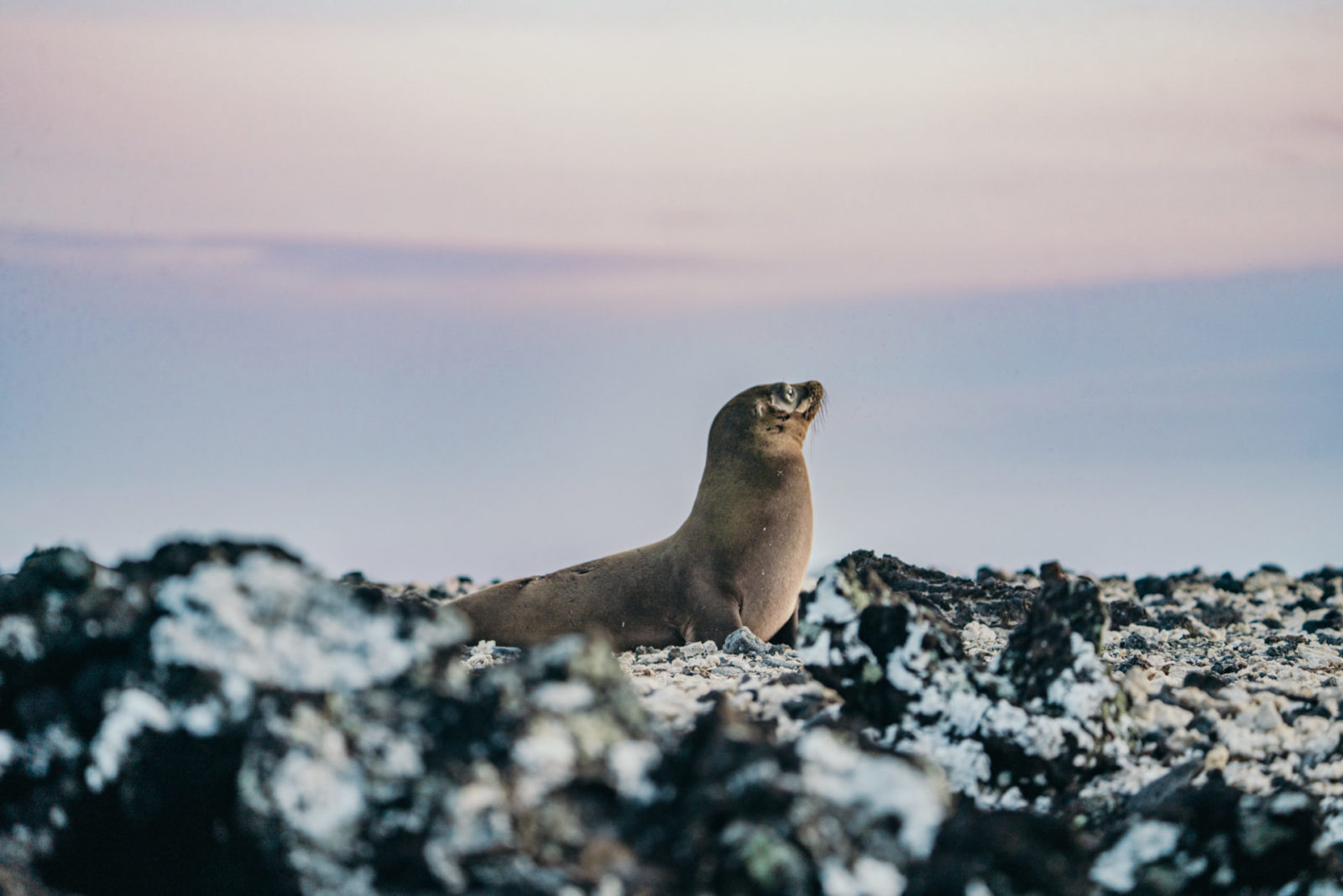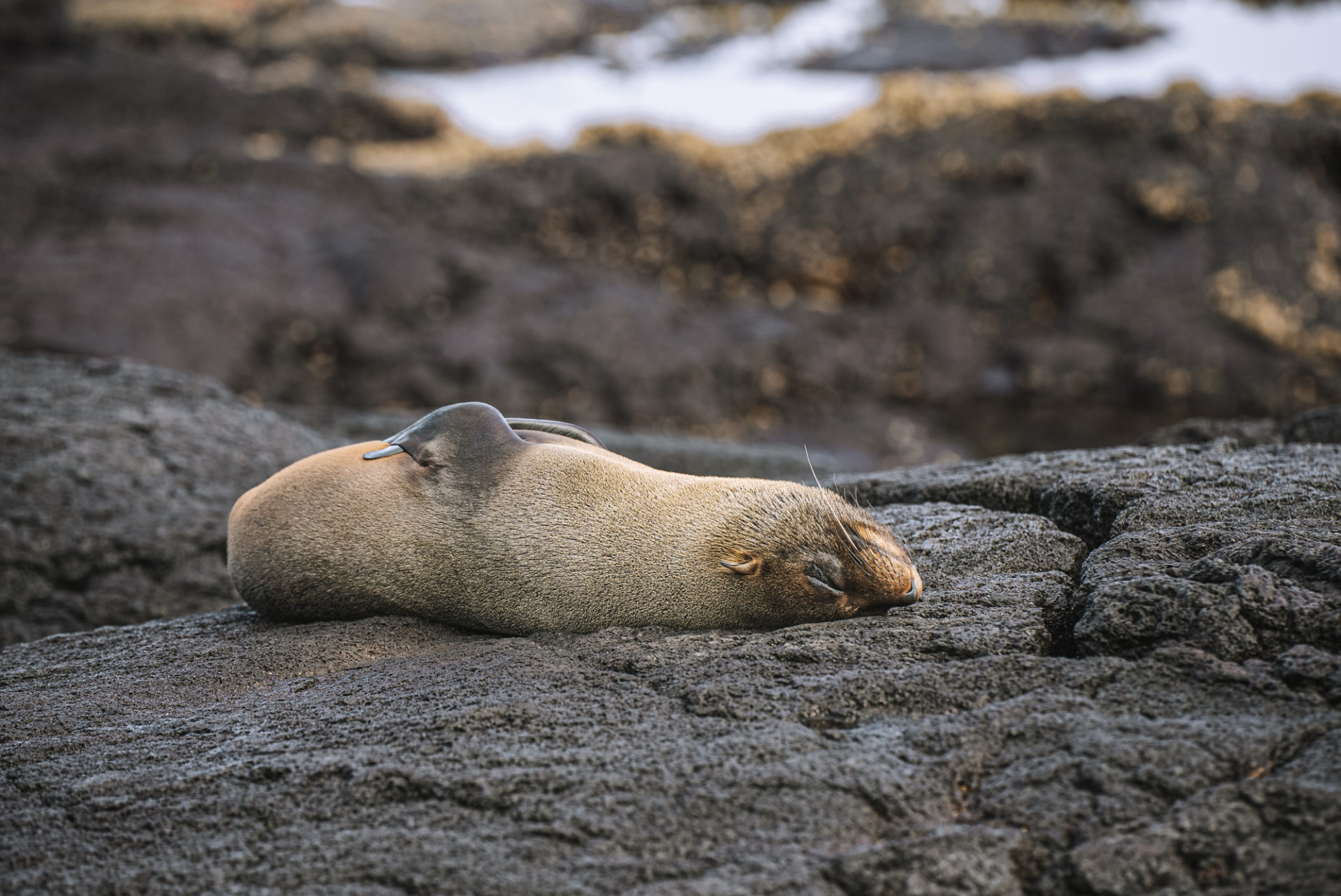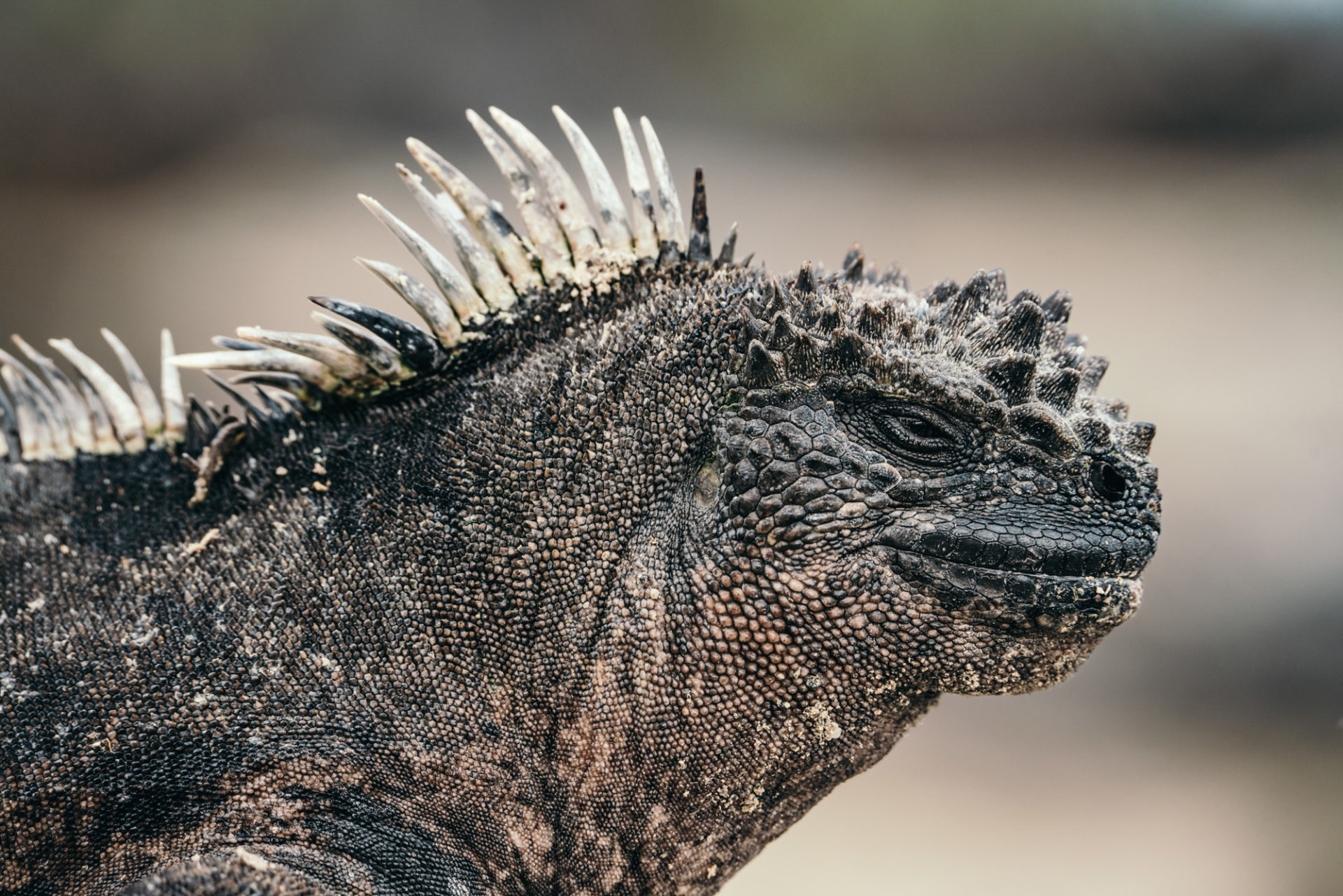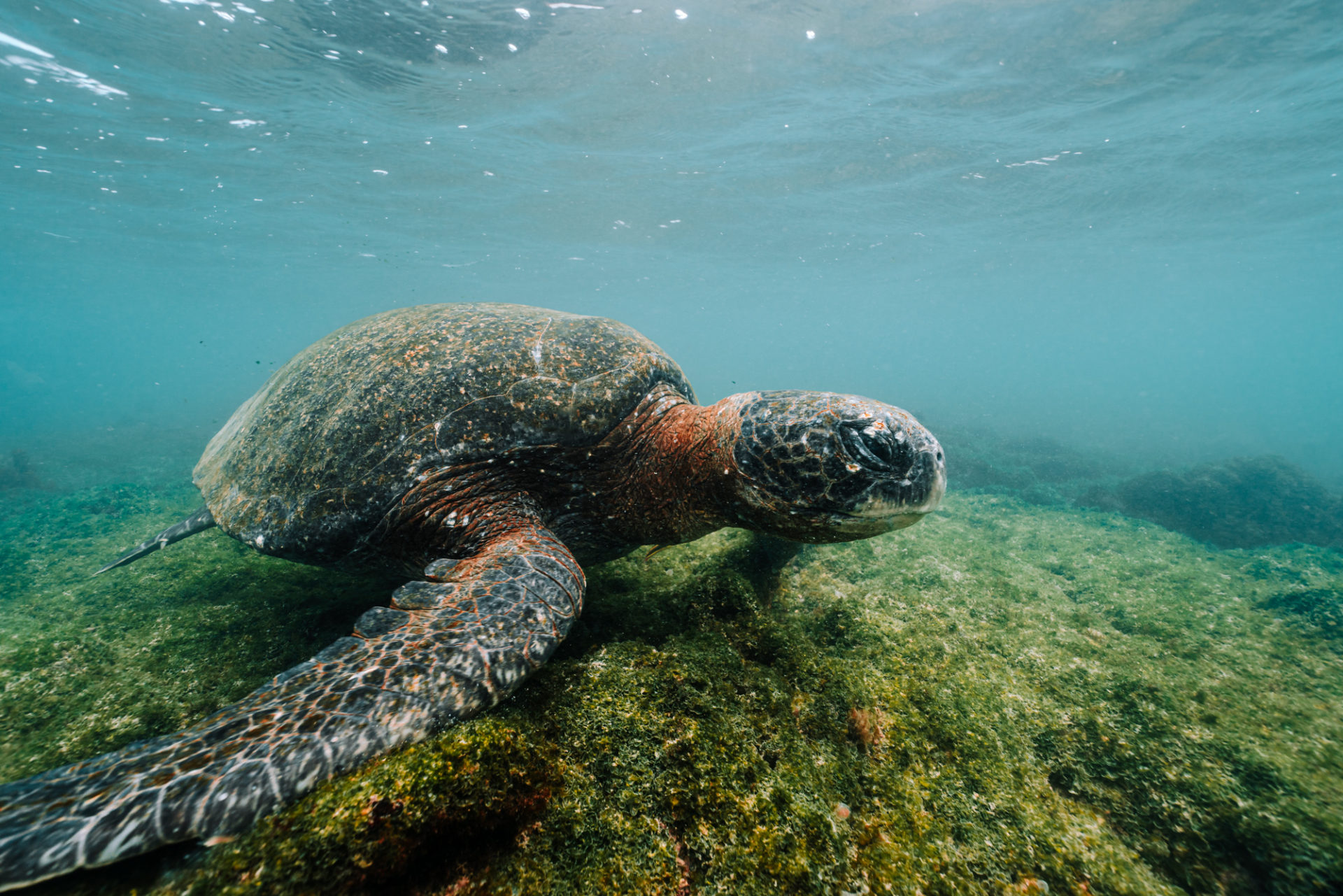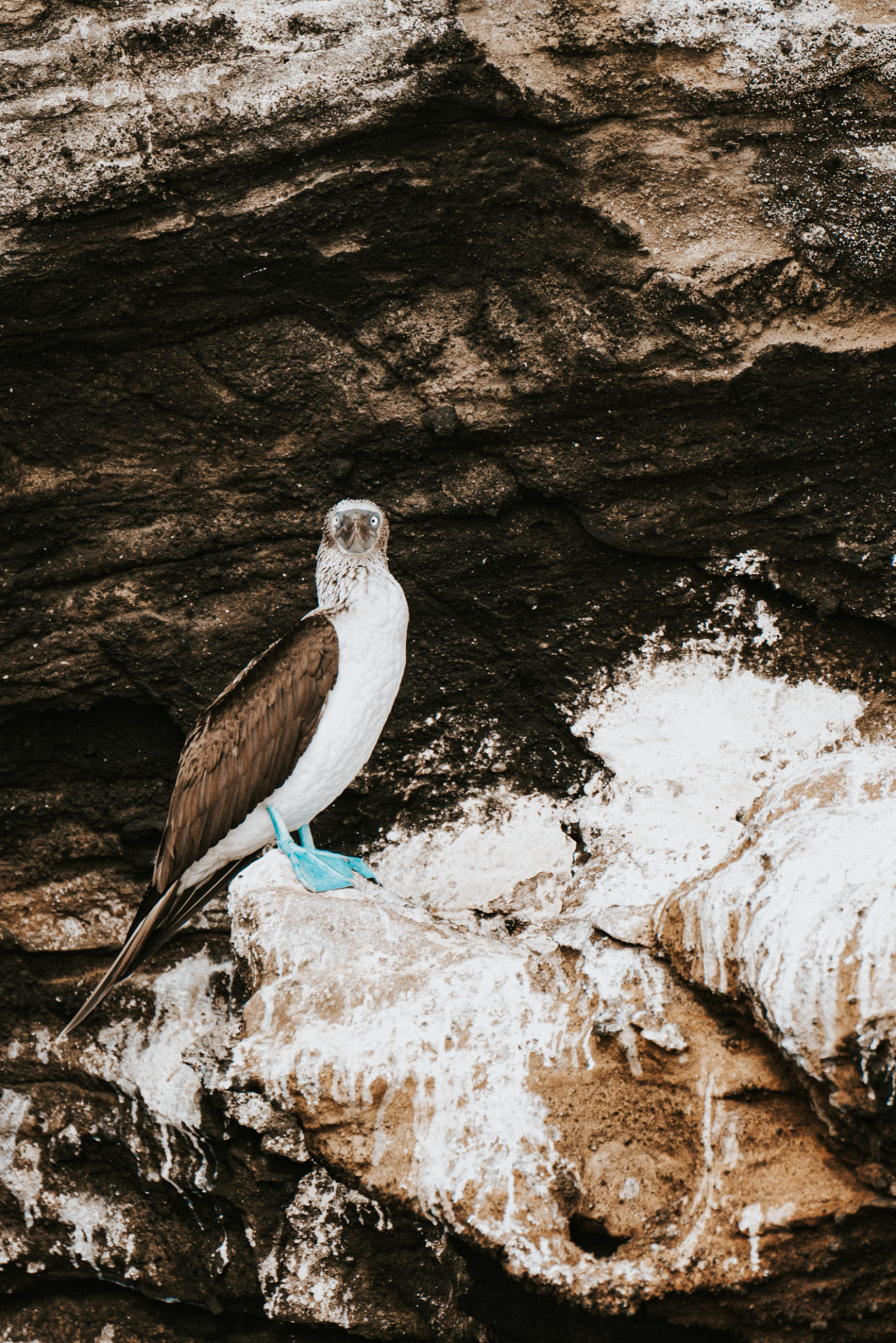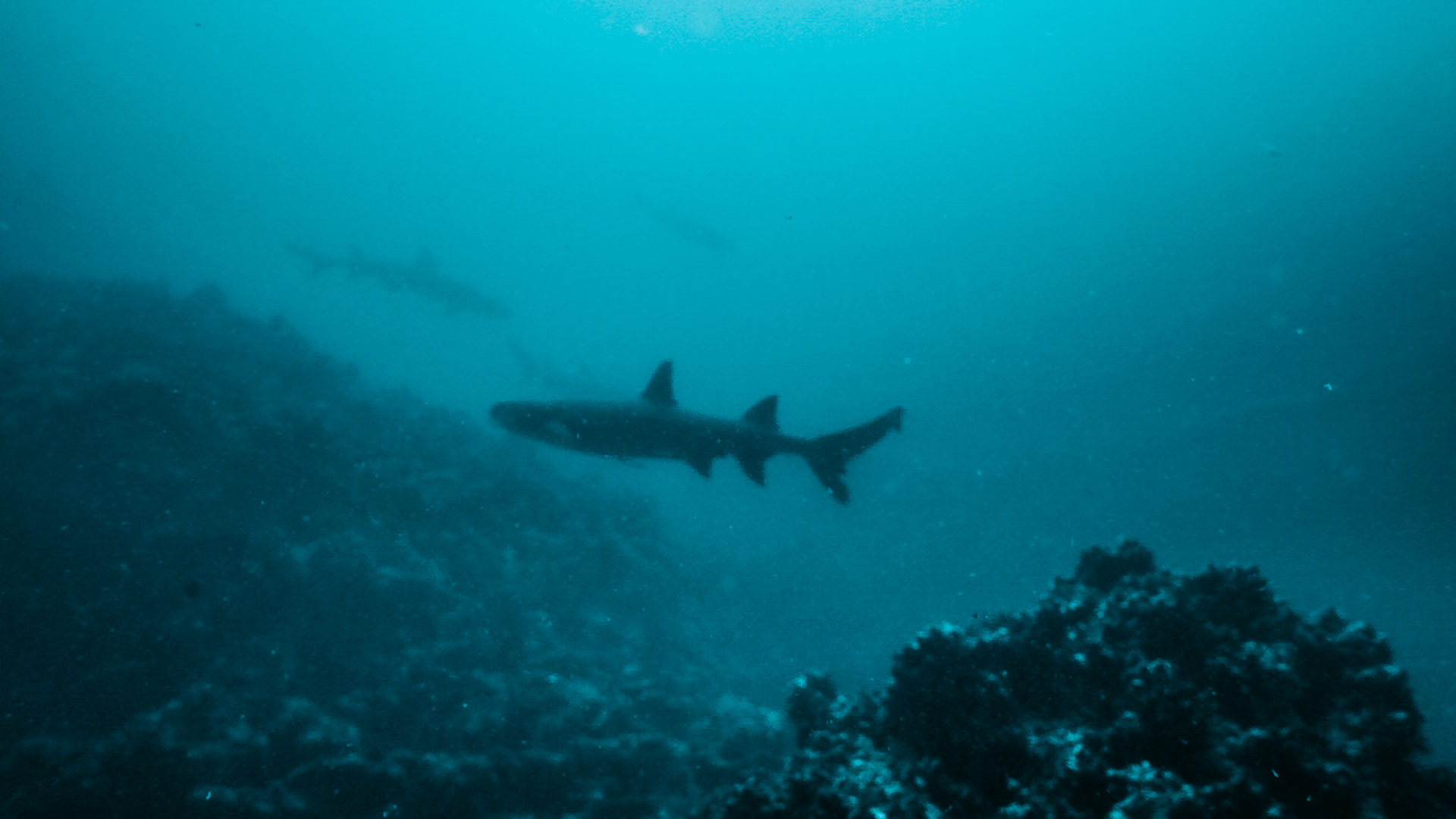Located off the Pacific Coast of Ecuador in South America, the extraordinary Galapagos Islands were created millions of years ago by the fires deep within the Earth’s core.
*This post may contain affiliate links, as a result, we may receive a small commission (at no extra cost to you) on any bookings/purchases you make through the links in this post. As an Amazon Associate, we earn from qualifying purchases. Read our full disclosure
Thanks to the archipelago’s remote location and strategic position in the Pacific Ocean, the islands became a unique habitat for birds, mammals, and thriving marine life. For centuries, the biodiversity of the Galapagos wildlife has evolved without human interference or natural predators.
Today, the Galapagos Islands are home to a plethora of species, ranging from birds to mammals. Many of them are endemic species, found only in the Galapagos. In fact, about 80% of bird species and 97% of reptiles and mammals are endemic animals on the Galapagos Islands. The Galapagos animals had to adapt to the islands’ harsh conditions and in turn, evolved into distinct subspecies. Many of these unique Galapagos animals played a key role in the conception of Charles Darwin’s Theory of Natural Selection and Evolution.
We were so lucky to spot many of these amazing creatures on our recent trip to the Galapagos Islands with Oniric Cruises. We got a chance to photograph them in all of their beauty and to learn so much about them from our Galapagos naturalist guide, Jaime.
Hope you enjoy this photo essay along with some information about the 18 exceptional animals found on the Galapagos Islands.
Animals of Galapagos Islands
Mammals
Galapagos Sea Lion
Status: Endangered
Endemic to Galapagos: Yes
Where to See: Scattered along the coasts of the archipelago
Galapagos sea lions are the most abundant marine animal in the archipelago and have become iconic Galapagos Islands species. You won’t have to look hard to find them. They are often splashing in the water or sunning themselves on the rocks and beaches along the coastline or sometimes, in less natural places.
They can “gallop” exceptionally fast across land and are known to hold their breath underwater for more than 10 minutes.
Both sexes of sea lions are relatively large, with males being distinctively larger than females. Males also have a prominent bump on their forehead and tend to get territorial and even aggressive during mating season.
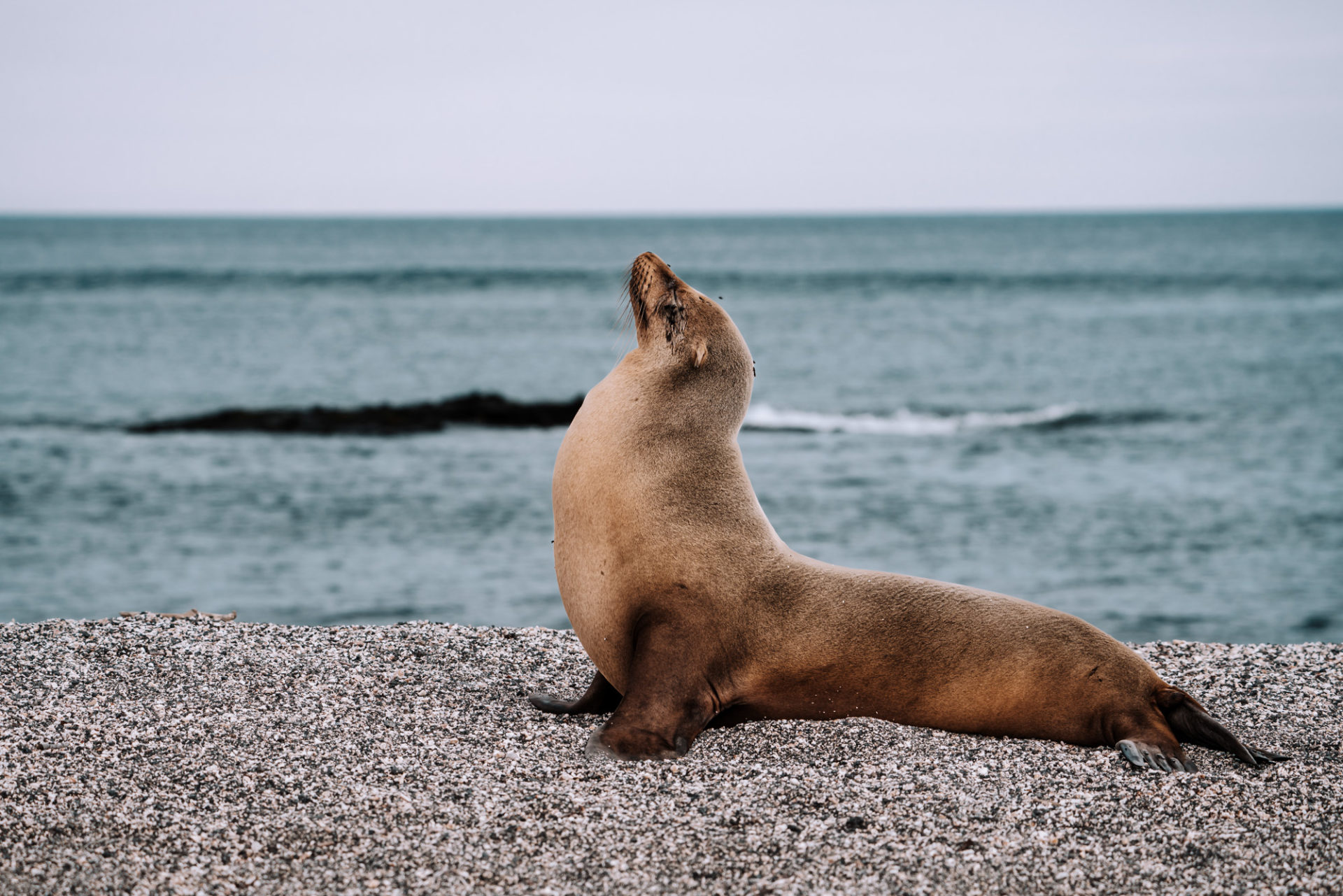
Traveling Soon? Here is a list of our favourite travel providers and accessories to help get you ready for your upcoming trip!

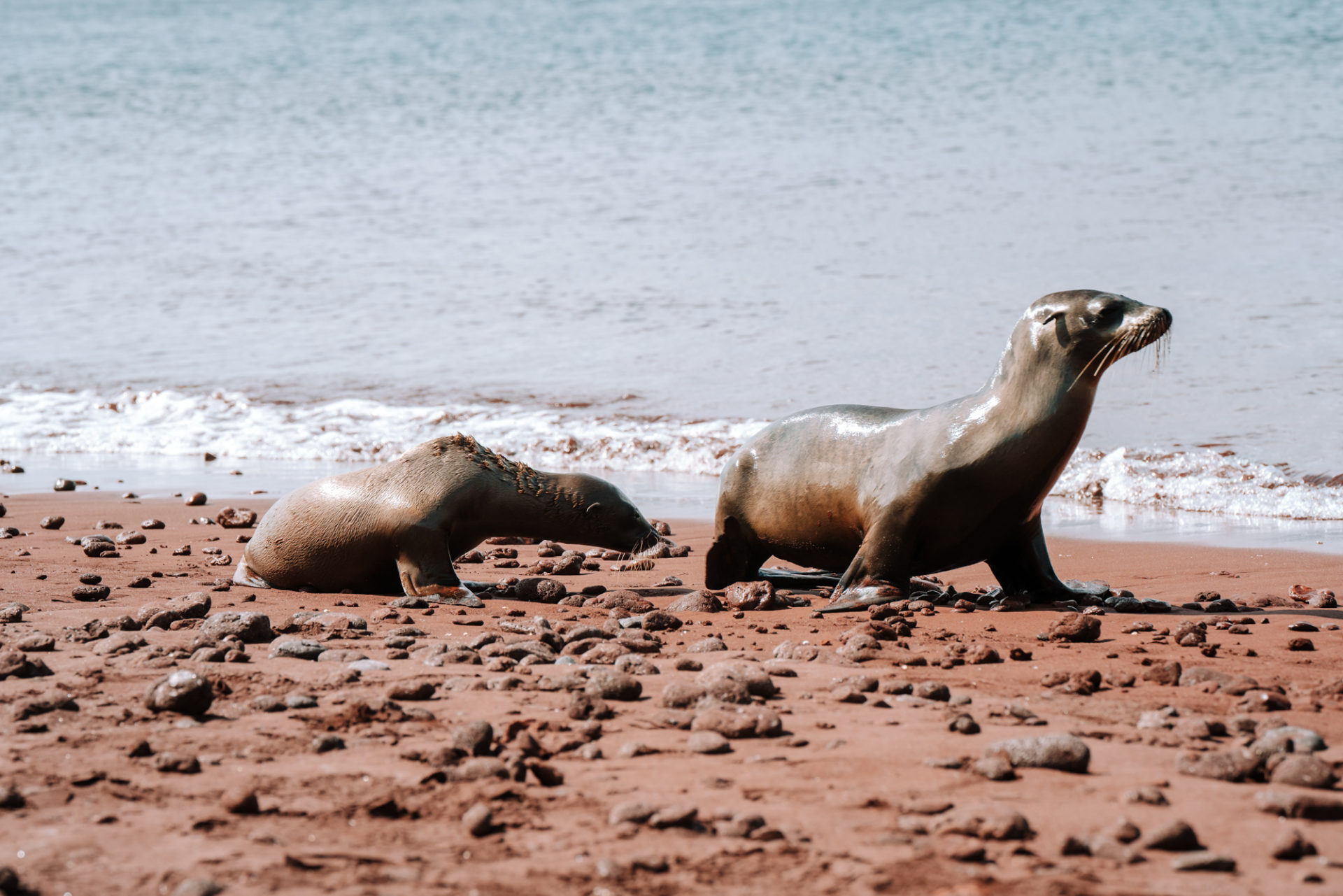
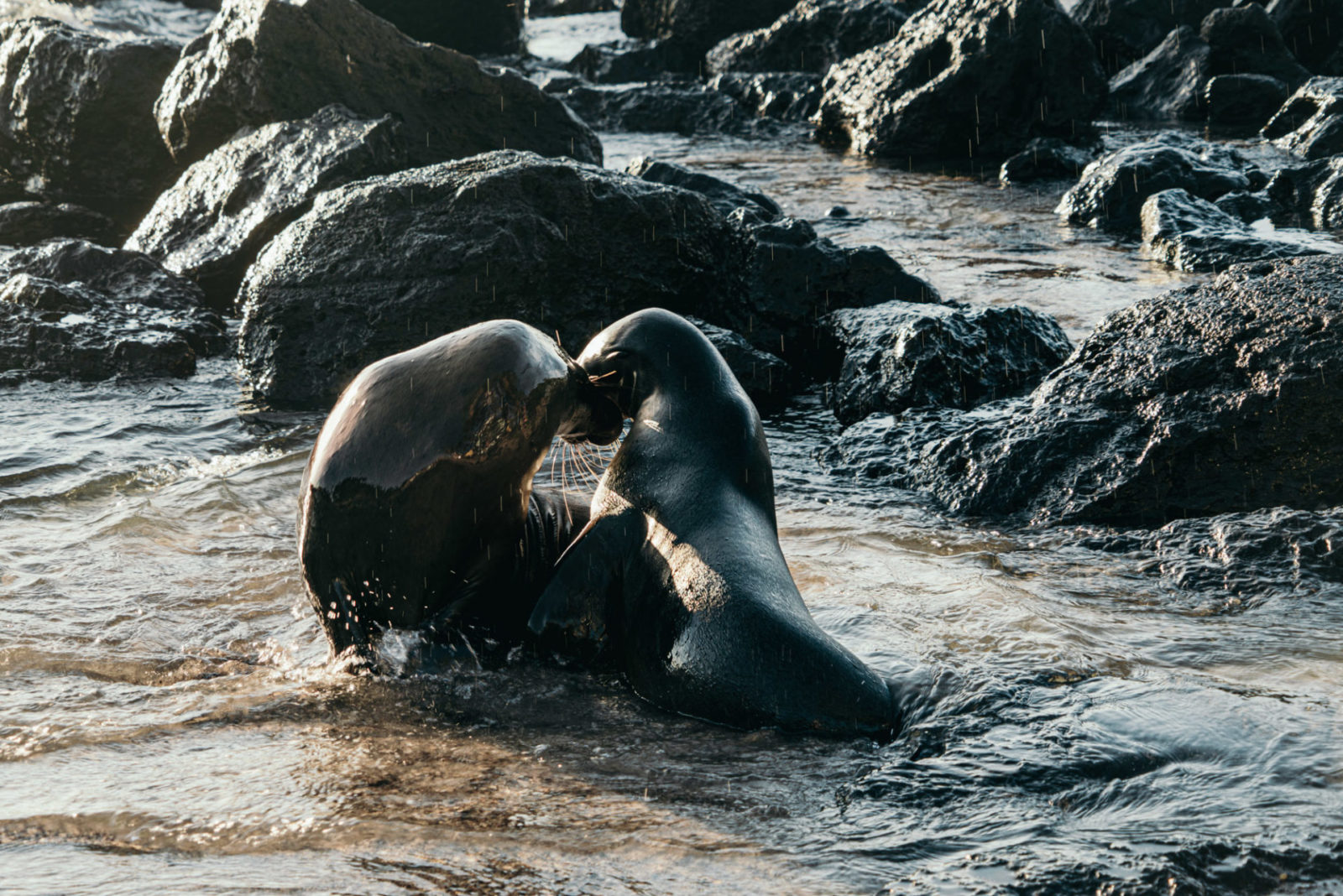
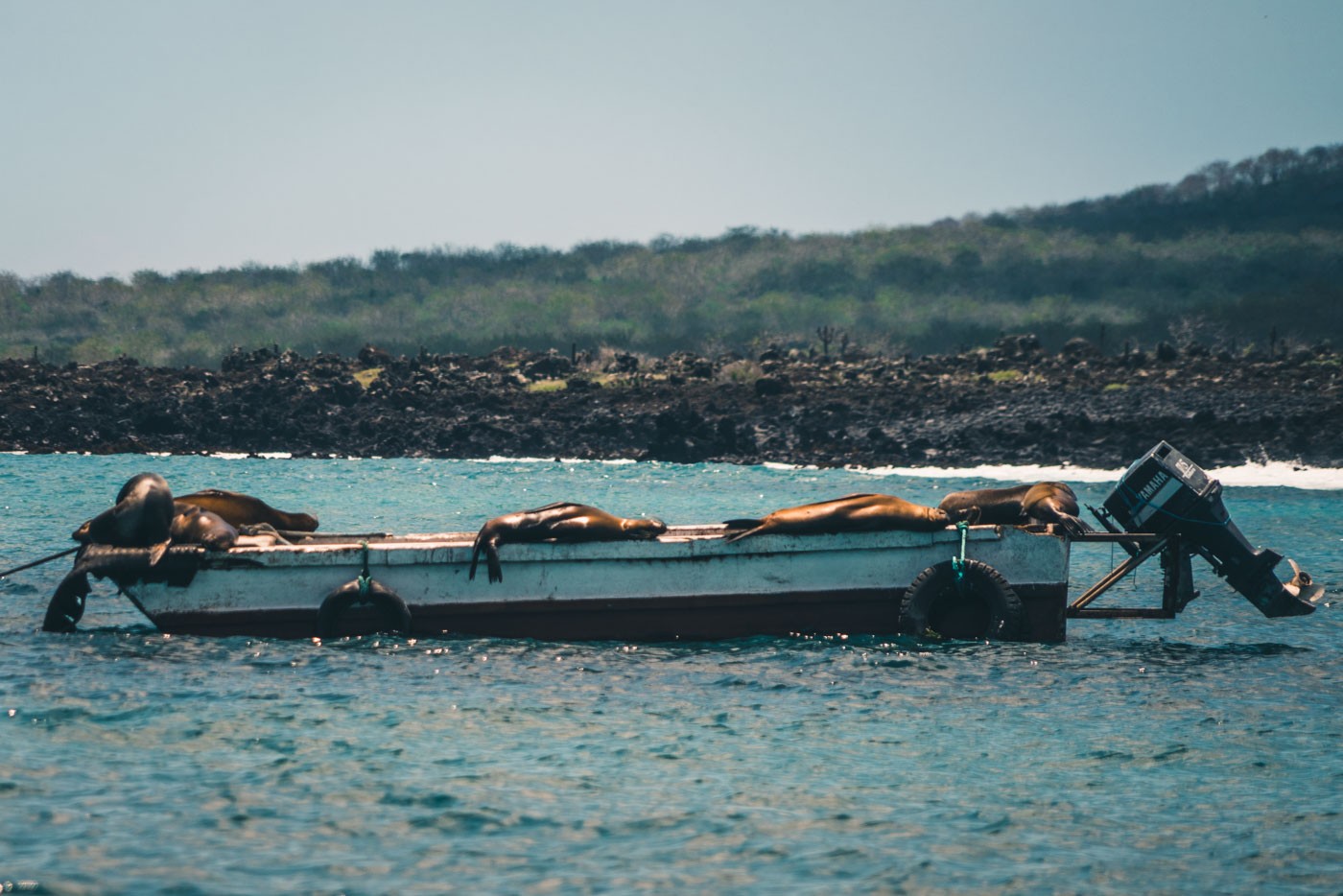
Galapagos Fur Seal
Status: Endangered
Endemic to Galapagos: Yes
Where to See: James Bay (Santiago Island), Darwin Bay (Genovesa Island)
Galapagos fur seal is definitely more unique and rare to see in the Galapagos. Thanks to their thicker fur, they prefer to lounge on the rocky terrain of the Galapagos’ western islands.
Fur seals are a smaller and fuzzier relative of the Galapagos sea lion. They’re less social than sea lions and prefer shadier areas, like lava crevices.
They live in large colonies and are excellent nocturnal hunters thanks to their wide eyes. Fur seals feed on squid and small fish, making them vulnerable to extreme weather events. Along with sea lions, they’re considered endangered and have very low reproductive rates, bearing only one pup at a time.

Reptiles
Marine Iguana
Status: Vulnerable
Endemic to Galapagos: Yes
Where to See: Isabela, Fernandina, Española, Floreana, and Santa Cruz
The Galapagos marine iguana is an amazing example of adaptability. It is the only species of lizard on earth that can live and forage at sea and adapt its body size based on food supply. They spend their days sunbathing on the beaches or lava rocks, in an attempt to raise their body temperature before heading underwater.
There are 11 subspecies of Galapagos marine iguanas that vary in colour and size. Large black marine iguanas are often spotted on Isabela and Fernandina Island. Brightly coloured adults are more common on Española and Floreana islands. They’re known to huddle in groups at night to conserve heat and are especially active during mating season.
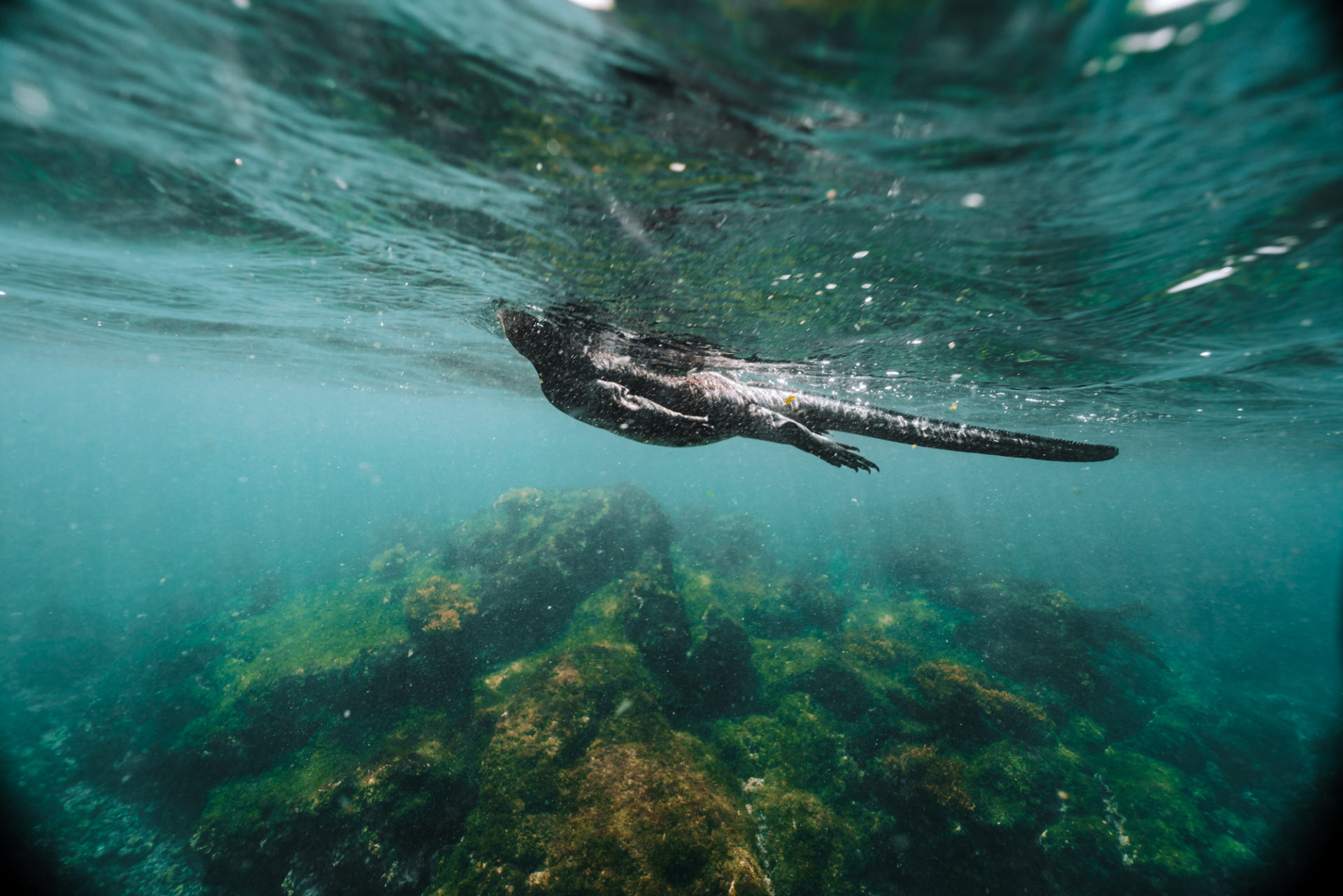
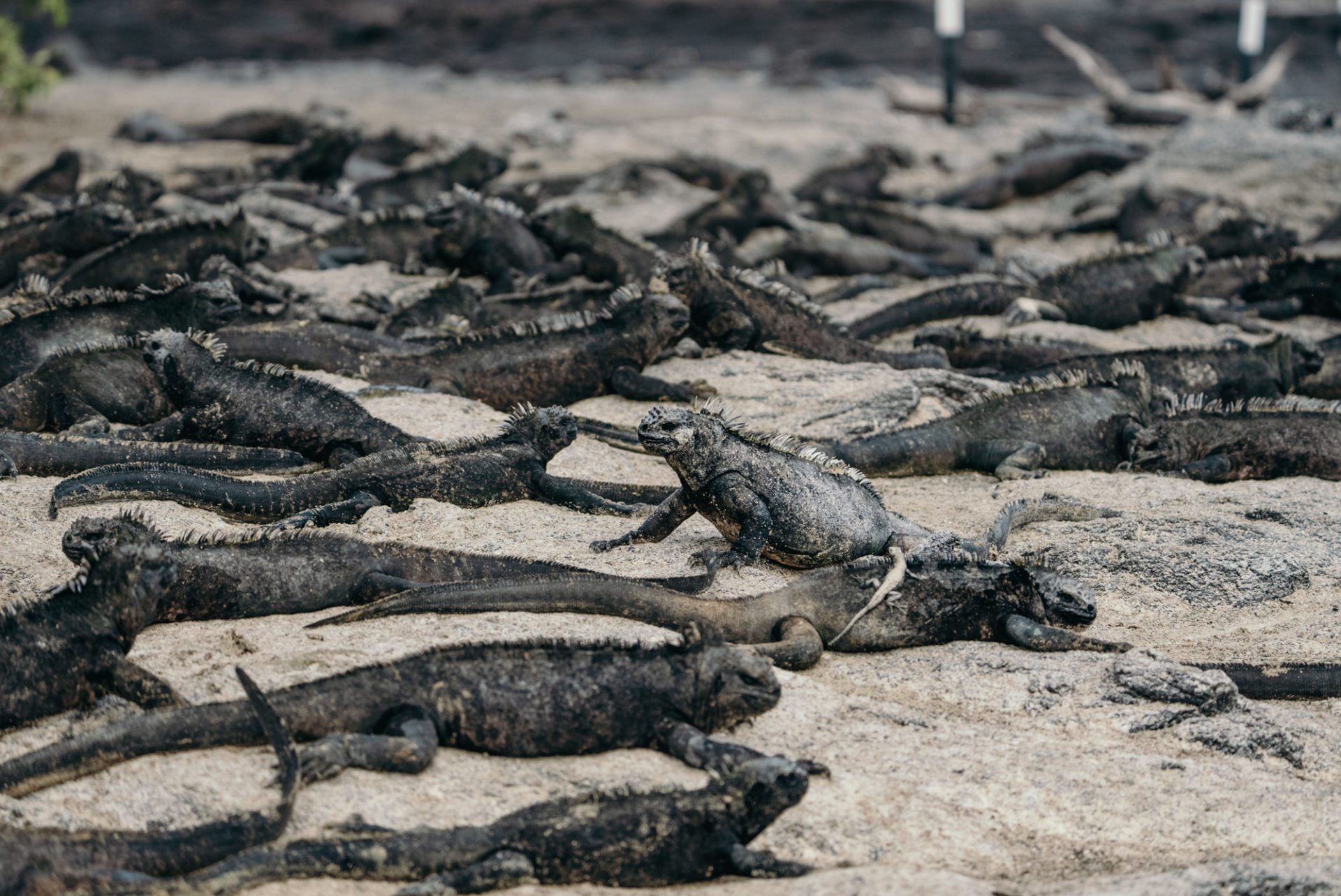

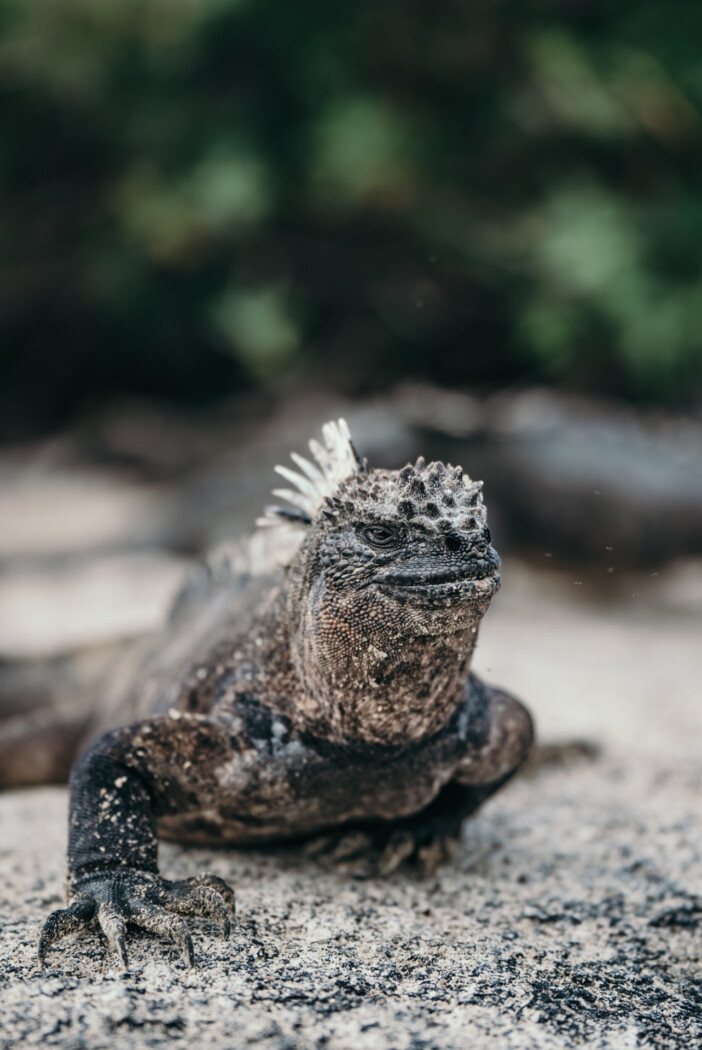
Land Iguana
Status: Vulnerable
Endemic to Galapagos: Yes
Where to See: Fernandina, Isabela, Santa Cruz, South Plaza, Baltra, Santiago, and North Seymour island.
Like marine iguanas, land iguanas are endemic to the Galapagos. In fact, marine iguanas are descendants of land iguanas that were displaced in the Galapagos Islands in extreme weather.
There are three species of land iguanas on the archipelago, including the yellow Galapagos land iguana, Santa Fé land iguana, and pink Galapagos iguana.
Land iguanas are large, cold-blooded reptiles that feed on plants and live in dry areas away from the water. The former two are vulnerable while the pink land iguana is one of the islands’ critically endangered species. You can find land iguanas on many islands in the Galapagos but the pink iguana is unique to the slopes of Wolf Volcano on Isabela Island.
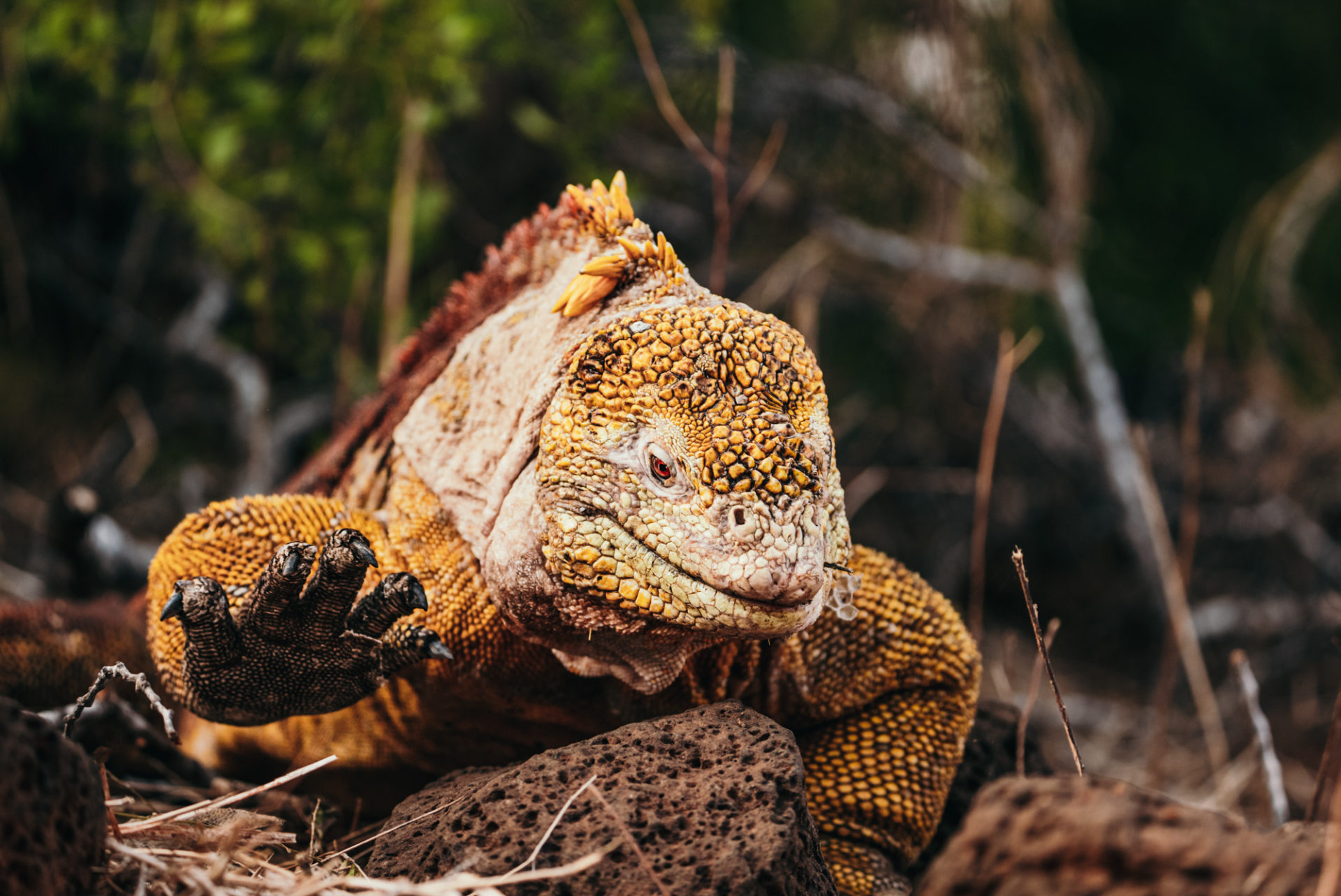
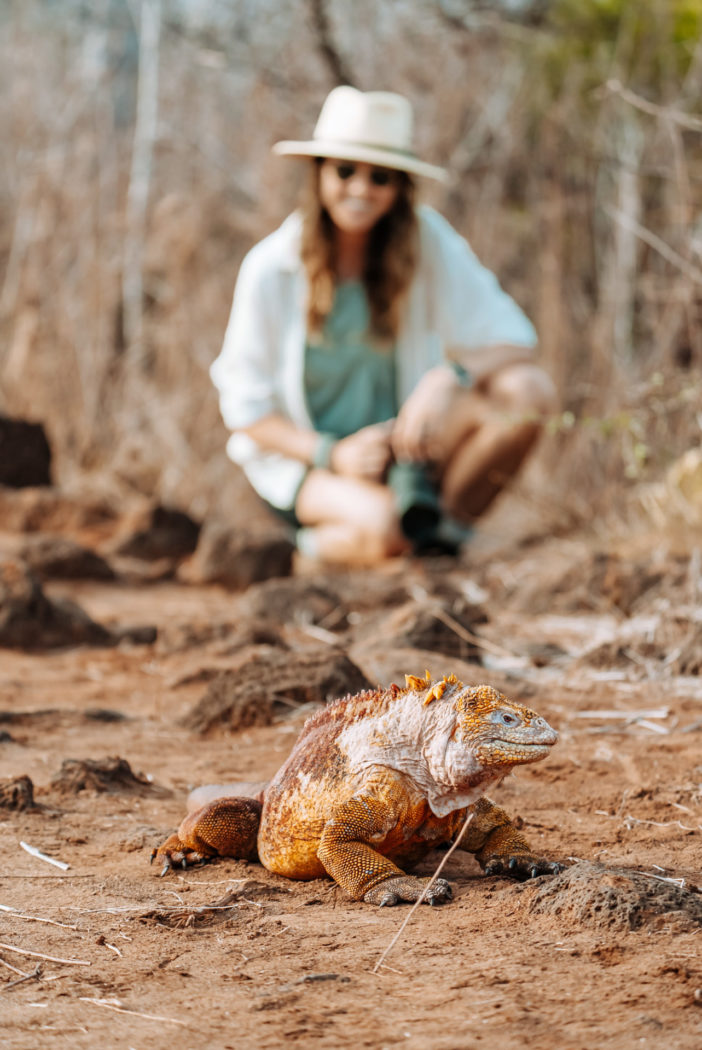
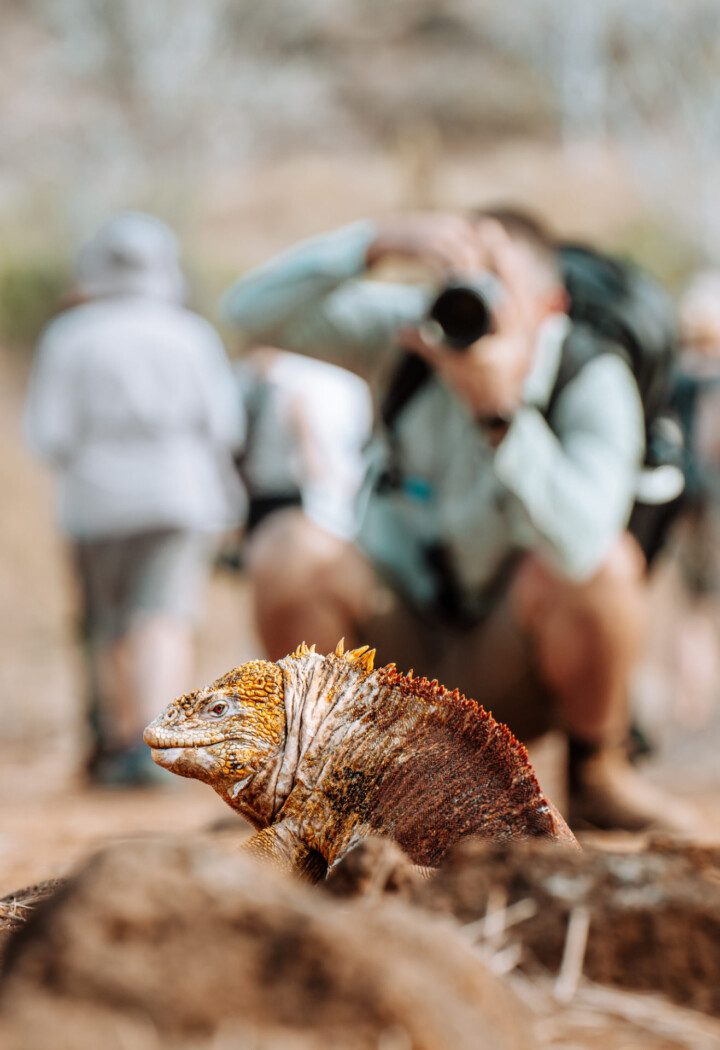
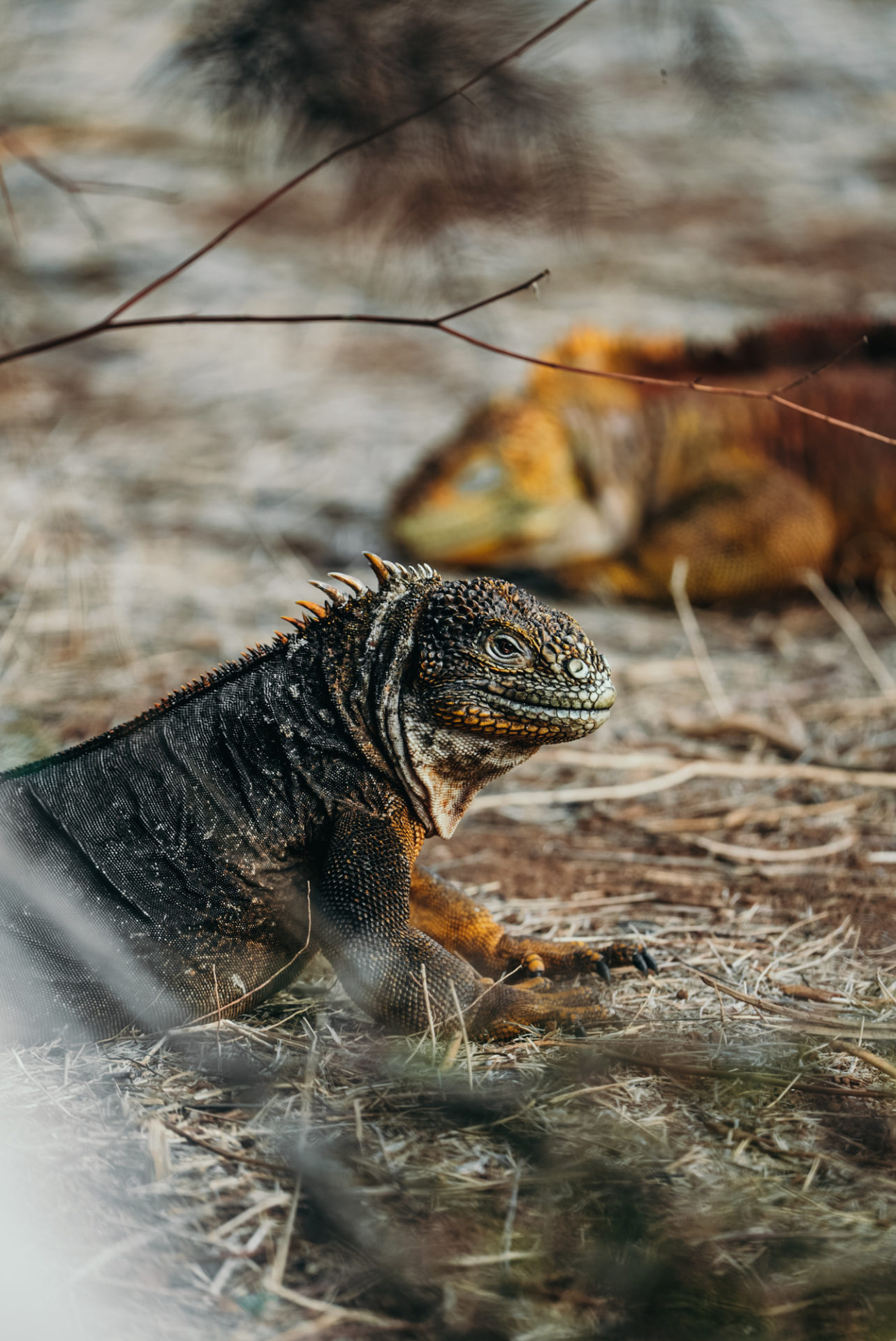
Green Sea Turtle
Status: Endangered
Endemic to Galapagos: No
Where to See: Coastal waters around the archipelago
Native to the tropical waters of the Pacific, green sea turtles are commonly spotted Galapagos Island creatures. They are a critical part of the marine ecosystem and are excellent swimmers that can even sleep underwater.
The Galapagos green sea turtle mates during the warmer months when females bury their eggs on the beach. The freshly hatched sea turtles dodge several predators like cormorants, albatrosses, and crabs as they race into the water. In their aquatic natural habitat, they battle to survive, facing sharks and frigatebirds until they reach maturity, 26 to 40 years later.
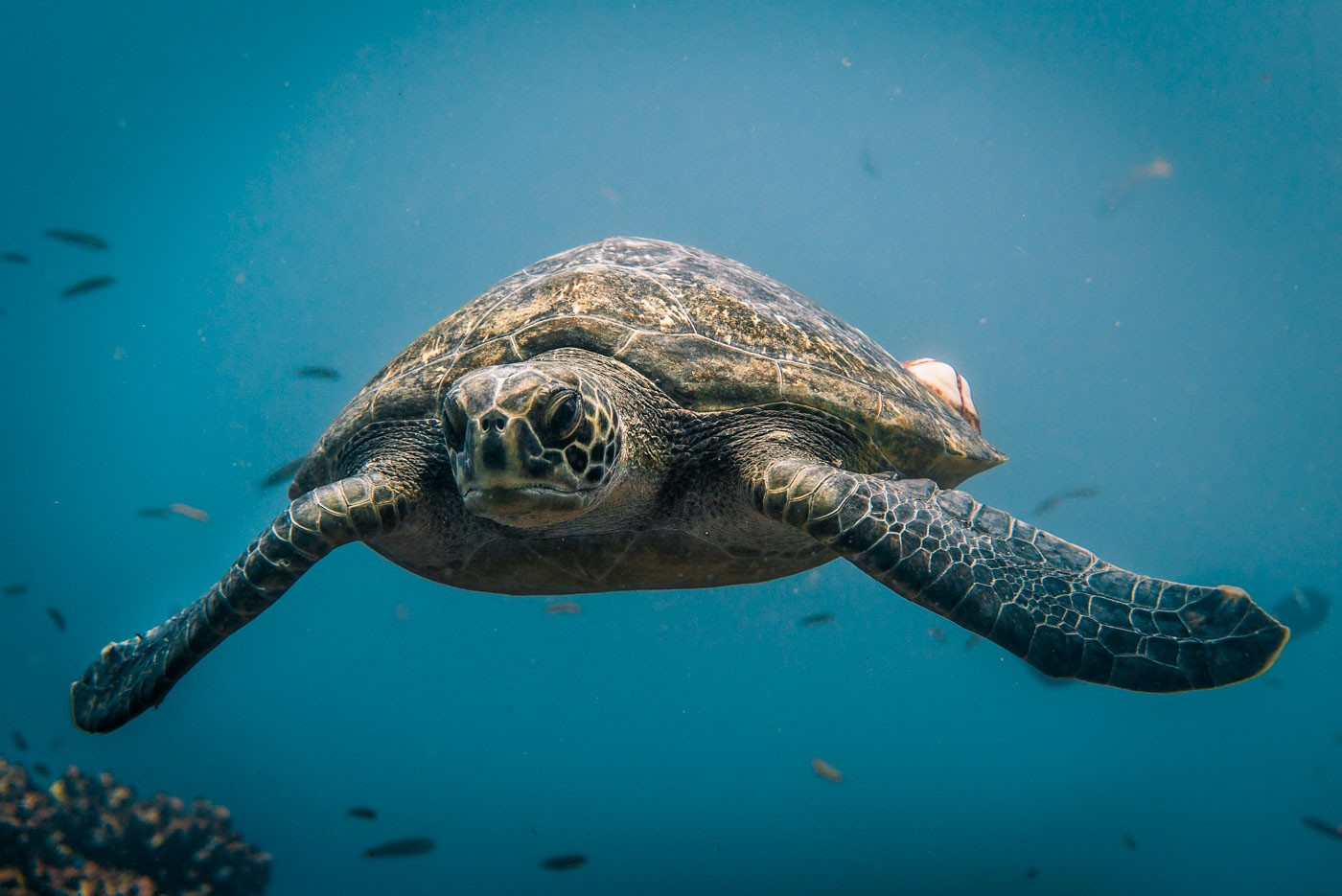
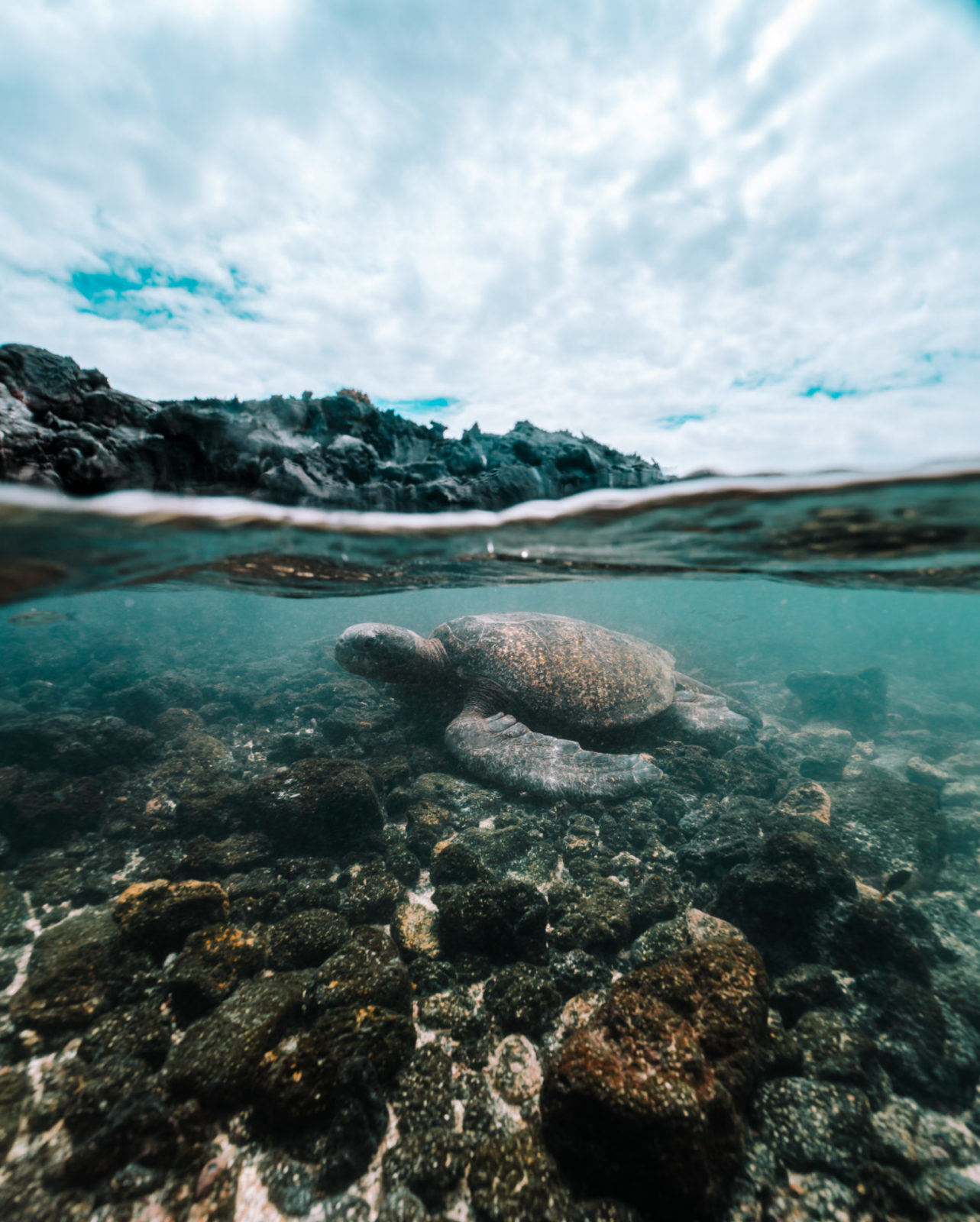
Lava Lizard
Status: Least Concern
Endemic to Galapagos: No
Where to See: Scattered along lowlands of the archipelago
Lava lizards are the most common reptile animals in the Galapagos Islands. Lava lizards look like mini iguanas. They are scattered throughout the islands and coastal regions of South America, taking names from their locations. Male species of the Galapagos lizard are often brighter in colour with rough, patterned skin and yellow speckles.
The Galapagos lava lizard is very territorial and uses push-ups as a display of masculinity and dominance. In other words, you may see them having a push-up contest to compete for lizard king status.
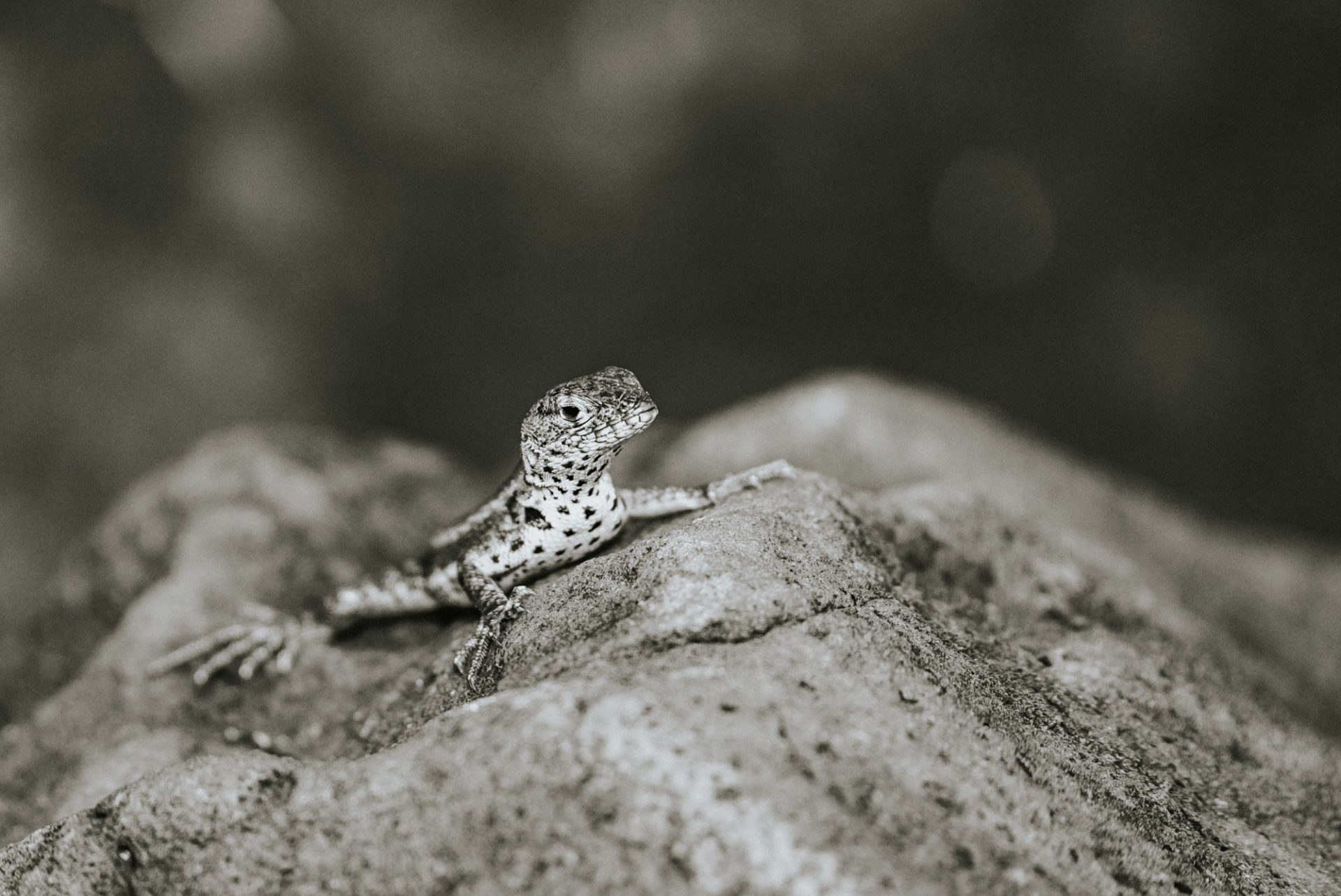
Giant Tortoise
Status: Endangered
Endemic to Galapagos: Yes
Where to See: Santa Cruz highlands, Alcedo Volcano on Isabela Island
The giant tortoises of the Galapagos Islands were some of the earliest animal species to inhabit the islands. They are by far the most famous animals from Galapagos Islands. So much so, the name Galapágos actually derives from the Spanish word for tortoise.
There were once 14 separate species of Galapagos tortoises, including the Pinta Island Tortoise, Fernandina Giant Tortoise, and the Saddleback tortoise, but only 12 remain today. The last extinct Galapagos giant tortoise was Lonesome George, a Pinta Giant Tortoise who died at the age of 102 years back in 2012. All attempts to mate him before his passing were, unfortunately, unsuccessful. As a result, the Pinta tortoise species, also known as the Abingdon Tortoise, are now officially extinct.
Galapagos island tortoise species are generally very large, averaging 250 kg (550 lbs) and 1.5 m (5 ft) in length. Given their 100+ year life span, they spend most of their time resting and can miraculously survive up to one year without food or water.
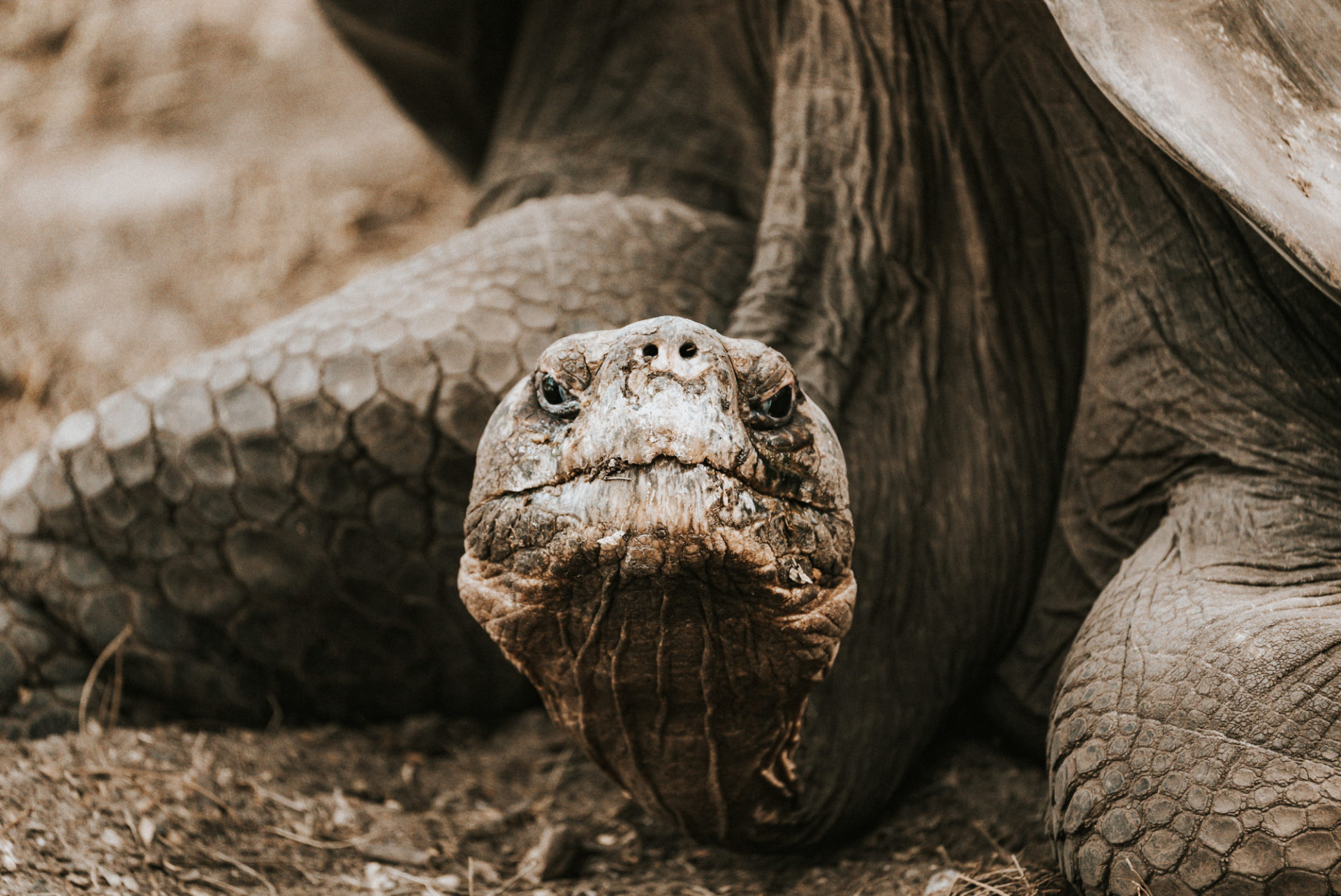
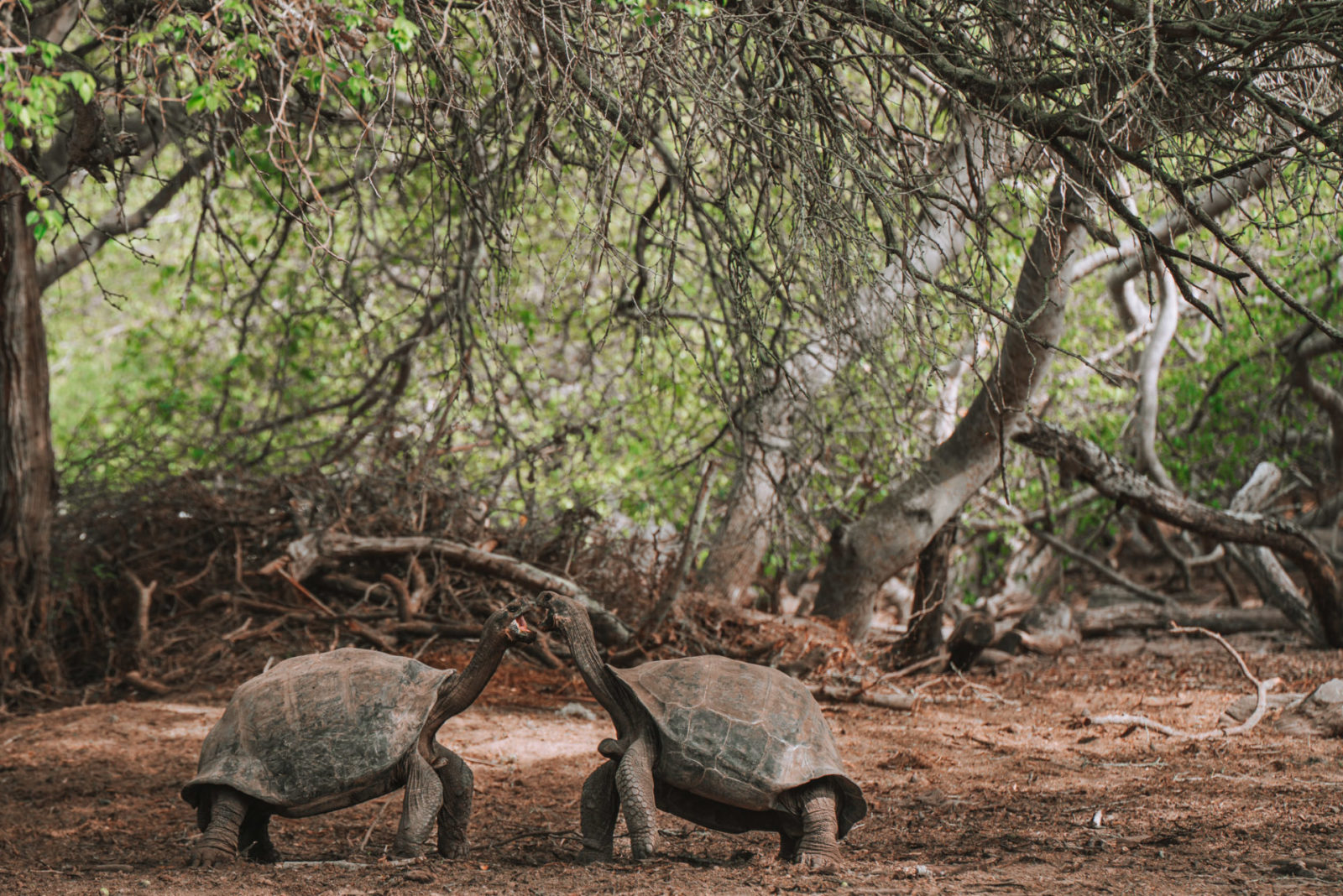

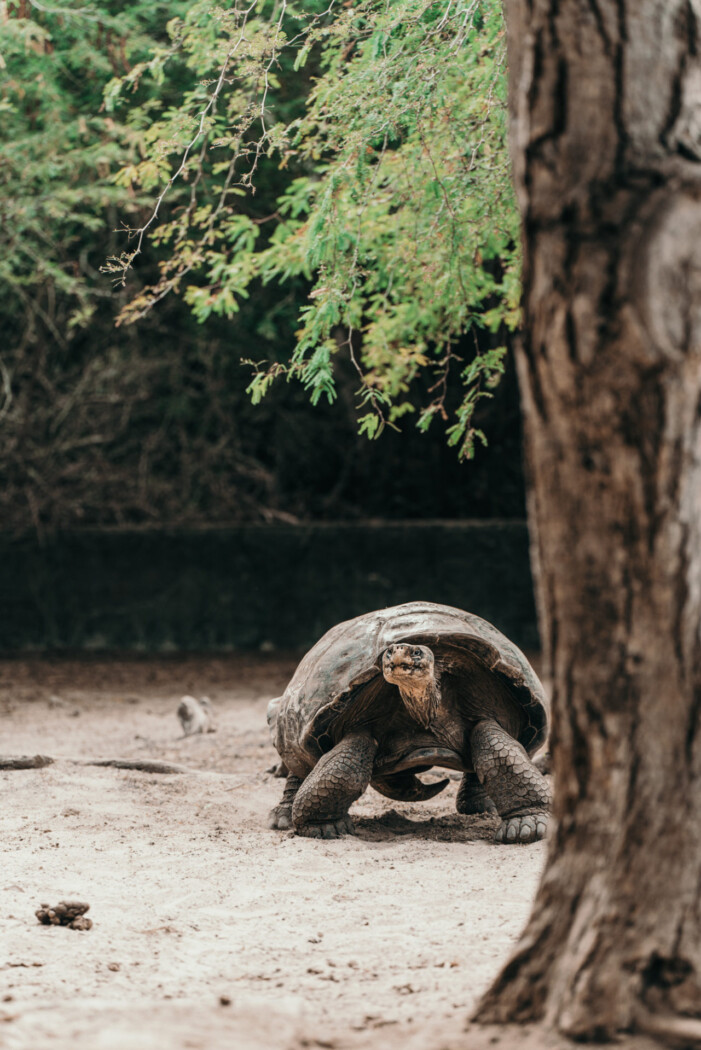
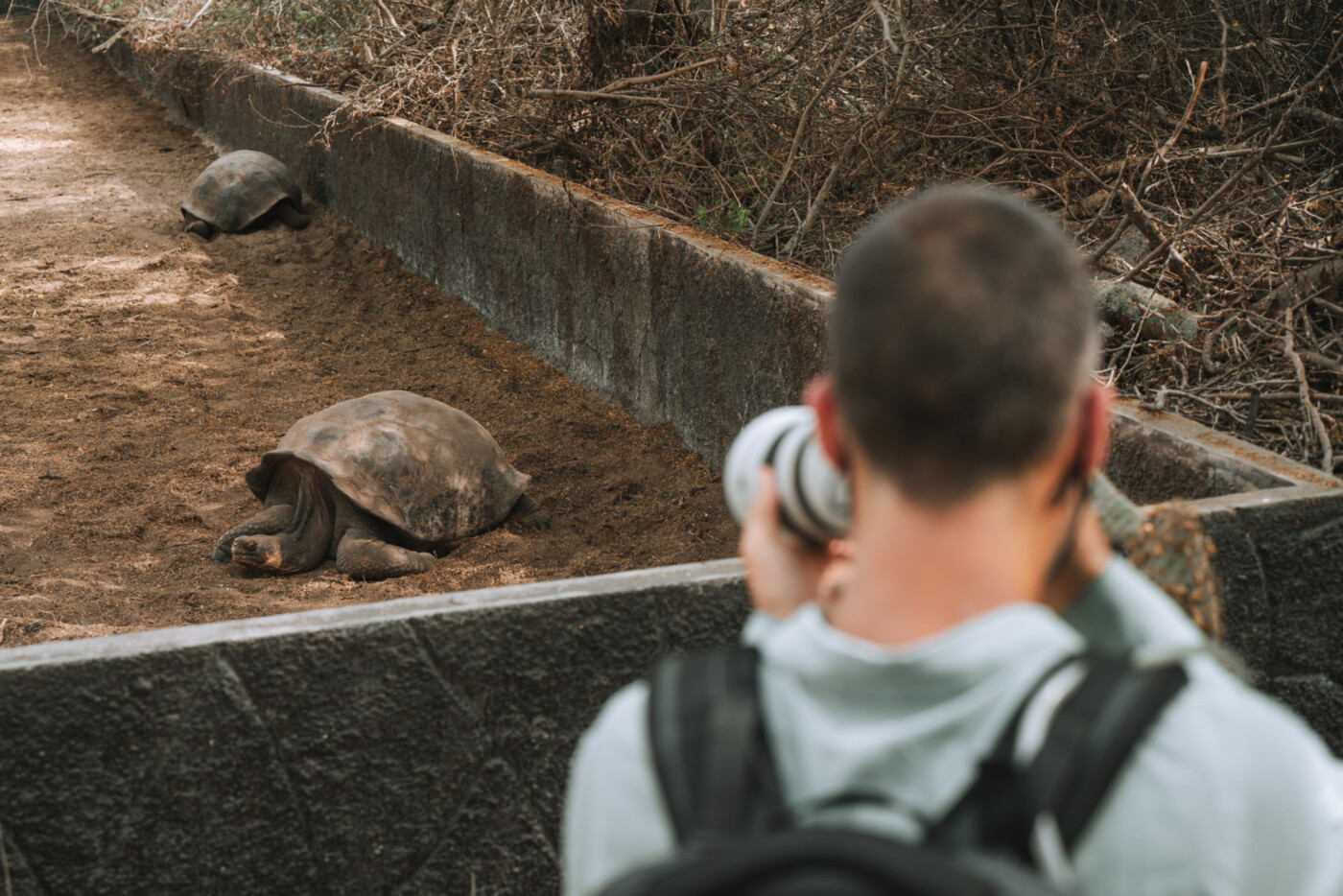
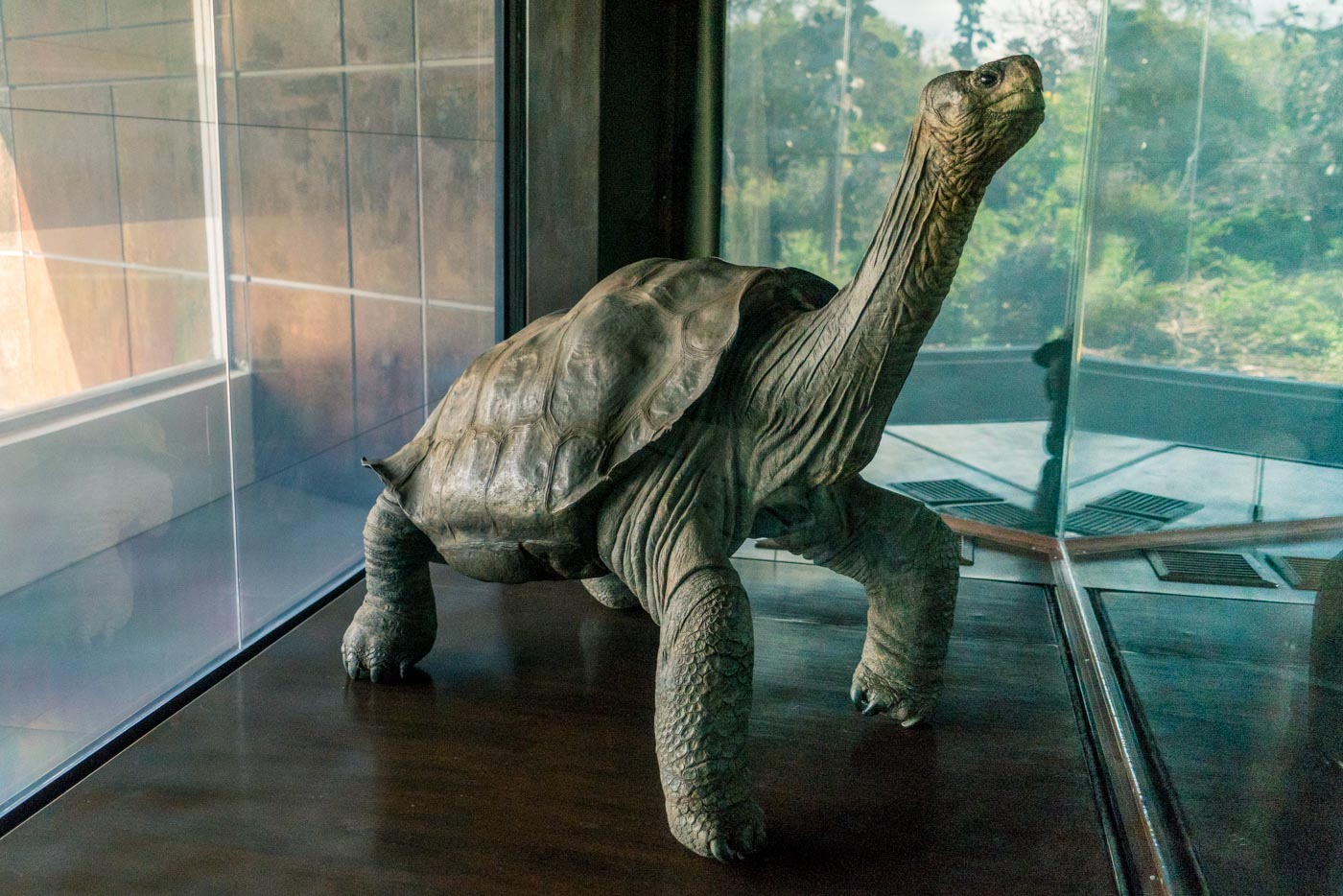
Birds
Galapagos Hawk
Status: Vulnerable
Endemic to Galapagos: Yes
Where to See: Isabela Island, Fernandina Island
An apex predator, the Galapagos hawk is one of the world’s rarest birds of prey. They have dark brown plumage and a large wingspan reaching 120 cm (47 inches) on average. Females are larger than males and mate with multiple partners throughout the nesting period. Then, males will take turns incubating the eggs and protecting the low-lying nests.
While the Galapagos hawk is not endangered, its small population does leave them vulnerable. They are major scavengers and feed on carcasses and invertebrates like giant centipedes and locusts.
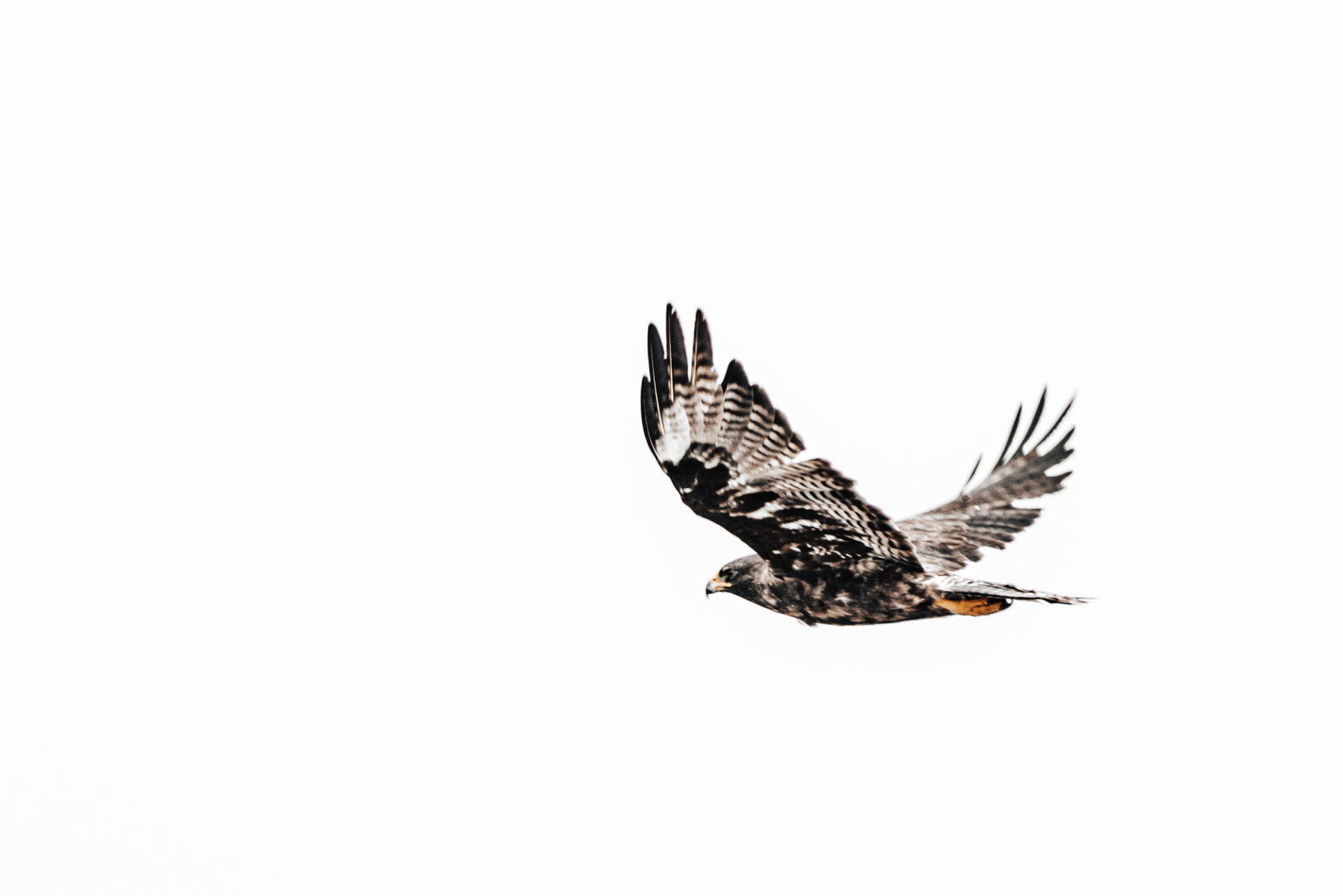

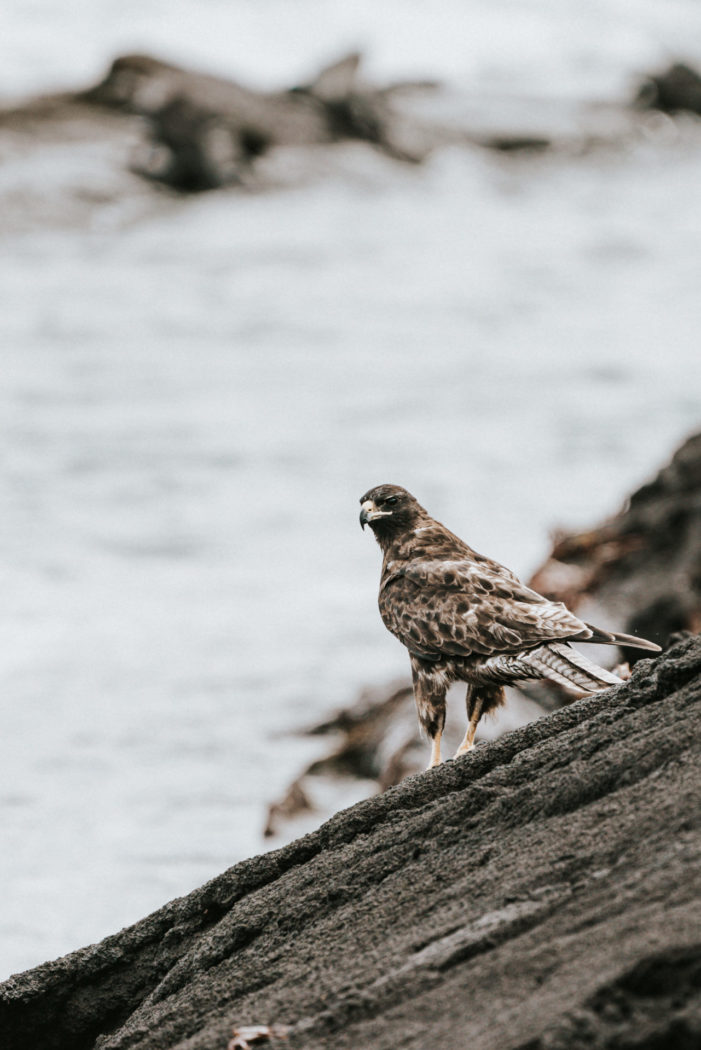
Galapagos Penguin
Status: Endangered
Endemic to Galapagos: Yes
Where to See: Isabela and Fernandina Islands
Galapagos penguins are the only penguin species in the world that live in a tropical climate. They’re the most northerly penguins and live in caves and crevices carved out of lava rocks. Like other penguins, they are very agile underwater and mate for life.
These tiny Galapagos Islands penguins survive on nutrients brought in from the cold Humboldt current. This makes them particularly vulnerable to climate change and ocean pollution. Over 75% of the population was wiped out during an El Niño in 1982 and now, it’s estimated that there is less than 2,000 Galapagos penguins.
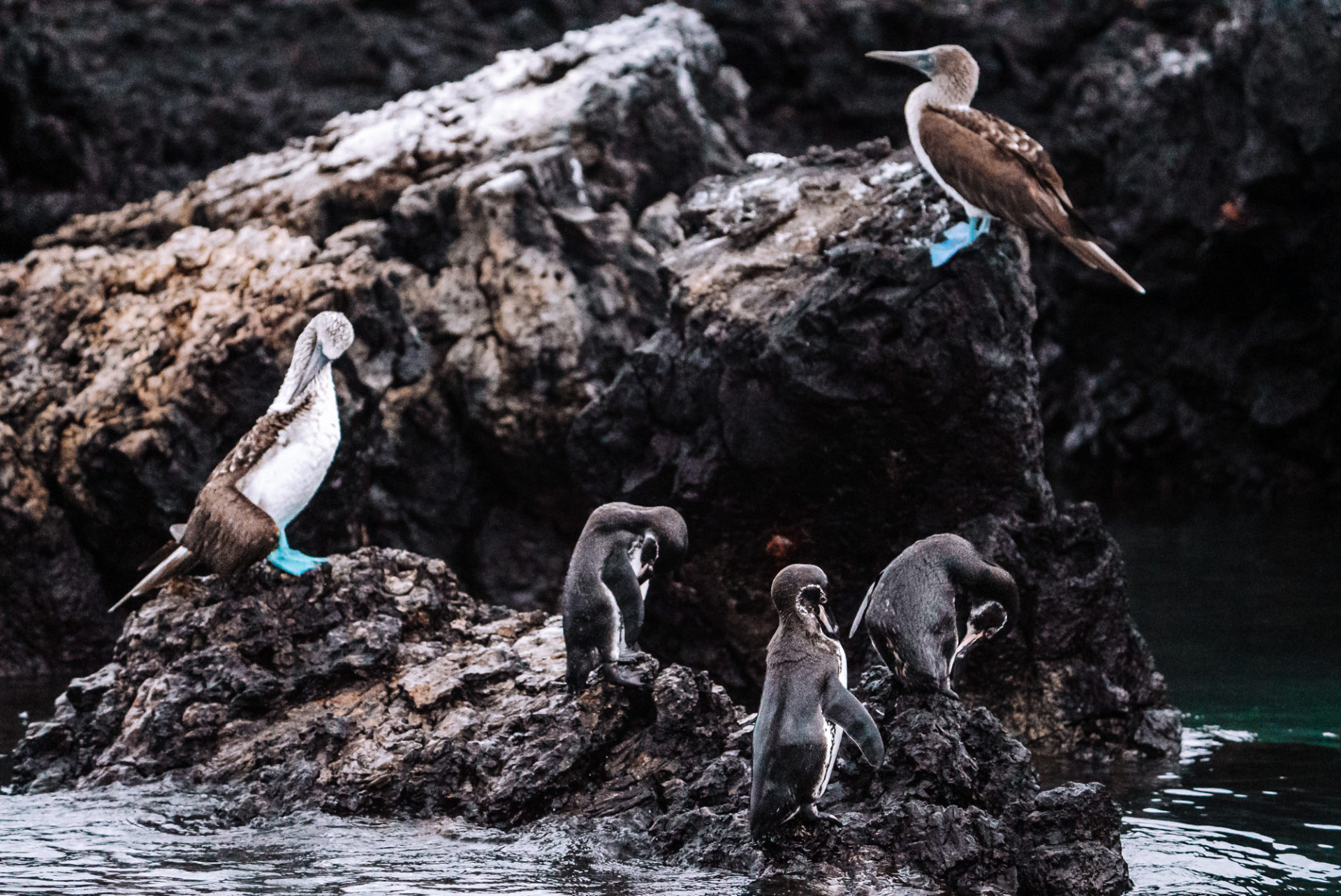

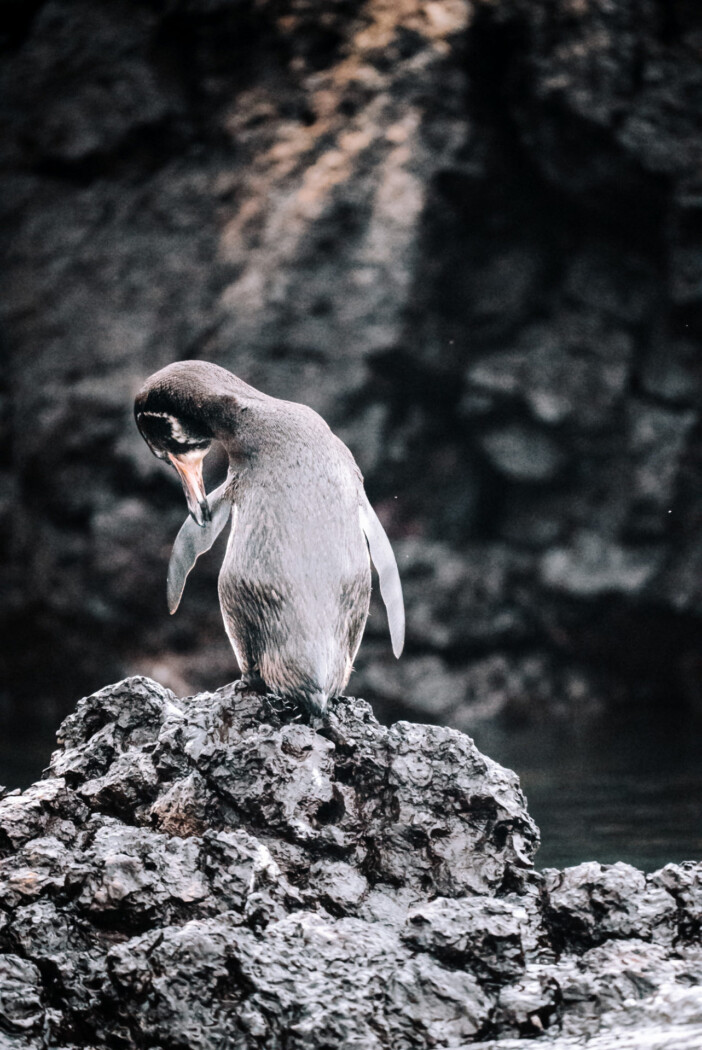
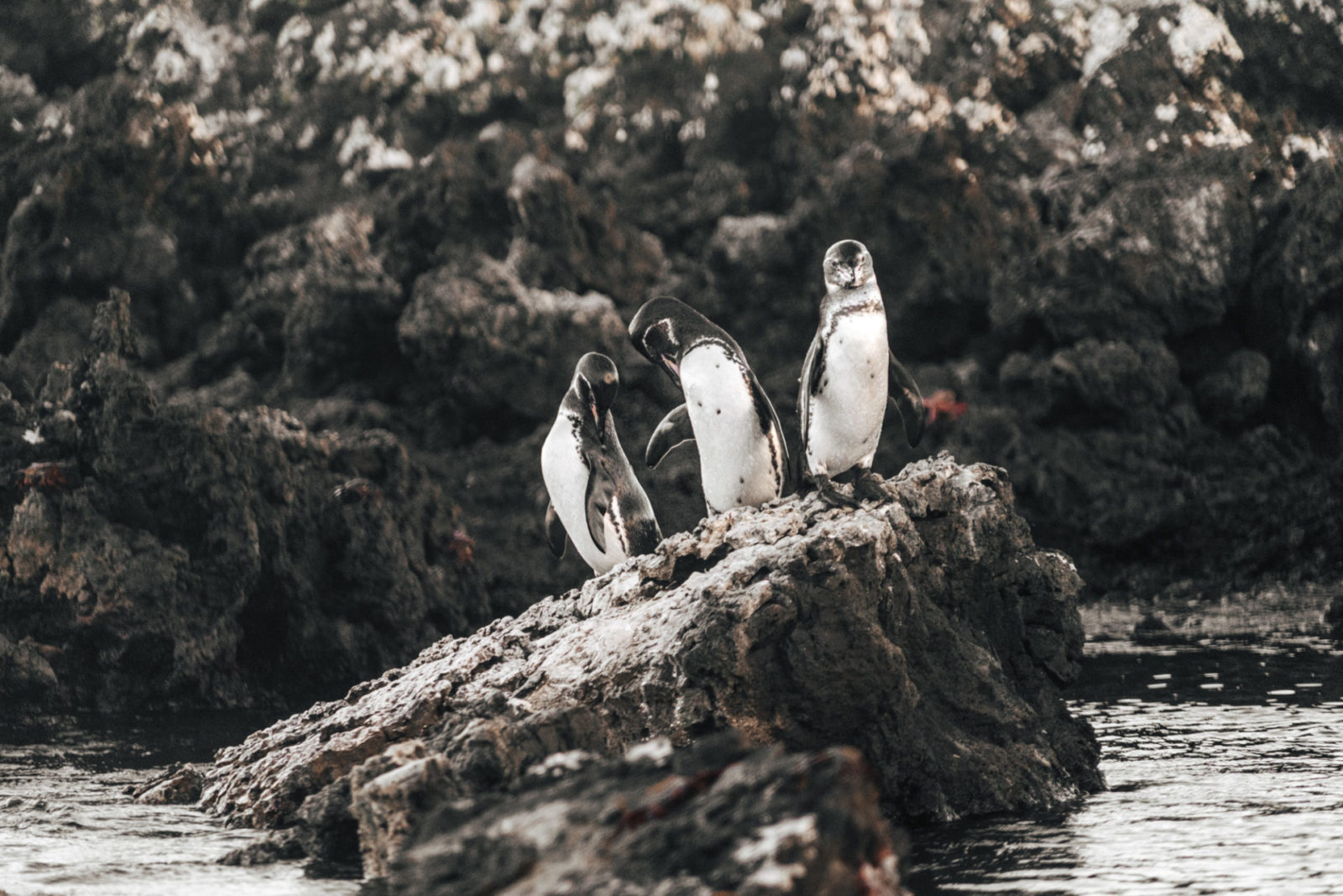
Galapagos Flamingo
Status: Least Concern
Endemic to Galapagos: No
Where to See: Punta Cormorant (Floreana Island), Cerro Dragon (Santa Cruz Island), and Puerto Villamil (Isabela Island)
One of six species of flamingo in the world, the American flamingo is a common Galapagos animal. They have distinct pink plumage with black-tipped wings and curved bills. They use their bills to filter through water and feed on crustaceans, mollusks, worms, algae, and seeds.
Flamingos of the Galapagos Islands live about 60 years and lay only one egg at a time. Babies are born grey and gradually turn pink as they feed on food loaded with carotenoids.
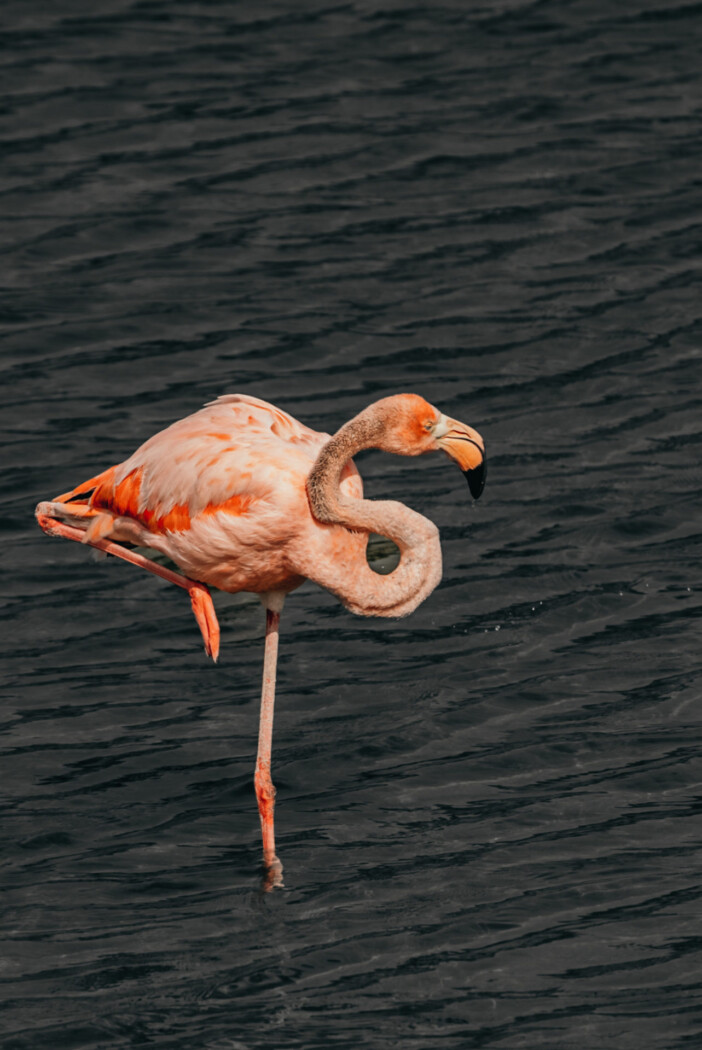

Darwin Finch
Status: Critically Endangered
Endemic to Galapagos: Yes
Where to See: Different species are present on different islands – see the finch distribution chart
There are 15 species of Galapagos finches present on the archipelago with 13 of them endemic to the area. These were made famous by Charles Darwin as he studied the unique beak shapes of each species. Beaks evolved to suit the seeds and invertebrates that finches were eating in their respective areas.
Some of Darwin’s finches include the mangrove finch, medium tree finch, and woodpecker finch. They are all similar in shape, size, and colour but have distinct differences based on their habitats. Each has a unique beak shape and size, as well as a unique song.

Blue-Footed Booby/Red-Footed Booby
Status: Least Concern
Endemic to Galapagos: No
Where to See: Red-Footed common on Genovesa and San Cristobal. Blue-Footed common on Isabela, Santa Cruz, and North Seymour Island.
Easily identifiable by their brightly coloured feet, the red-footed and blue-footed booby are clumsy Galapagos Islands birds. They move gracelessly on land but are powerful flyers and expert divers. They can accelerate up to 90 km/h (60 mph) before plunging into the water to capture their prey at a depth of 25 m (80 ft).
Boobies are very aerodynamic and feast on schools of anchovies and sardines. Of the three species, red-footed boobies are the smallest and have longer toes, allowing them to grip onto tree branches. They are also the hardest to spot, found primarily on Genovesa island.

READ MORE: How to Plan a Responsible Trip to the Galapagos
Flightless Cormorant
Status: Vulnerable
Endemic to Galapagos: Yes
Where to See: Isabela Island, Fernandina Island
A flightless cormorant is an example of evolution. Flightless cormorants arrived in the Galapagos with wings used to flee predators. They then evolved away from flying due to the lack of predators on the isolated islands. They shifted their abilities to swimming but are still mostly confined to the lava shores of Isabela and Fernandina Islands.
The flightless cormorant grew to breed underwater in a unique “courtship dance” where males and females intertwine their necks. They eat mostly eels and octopus and have bright turquoise eyes and black and brown plumage.
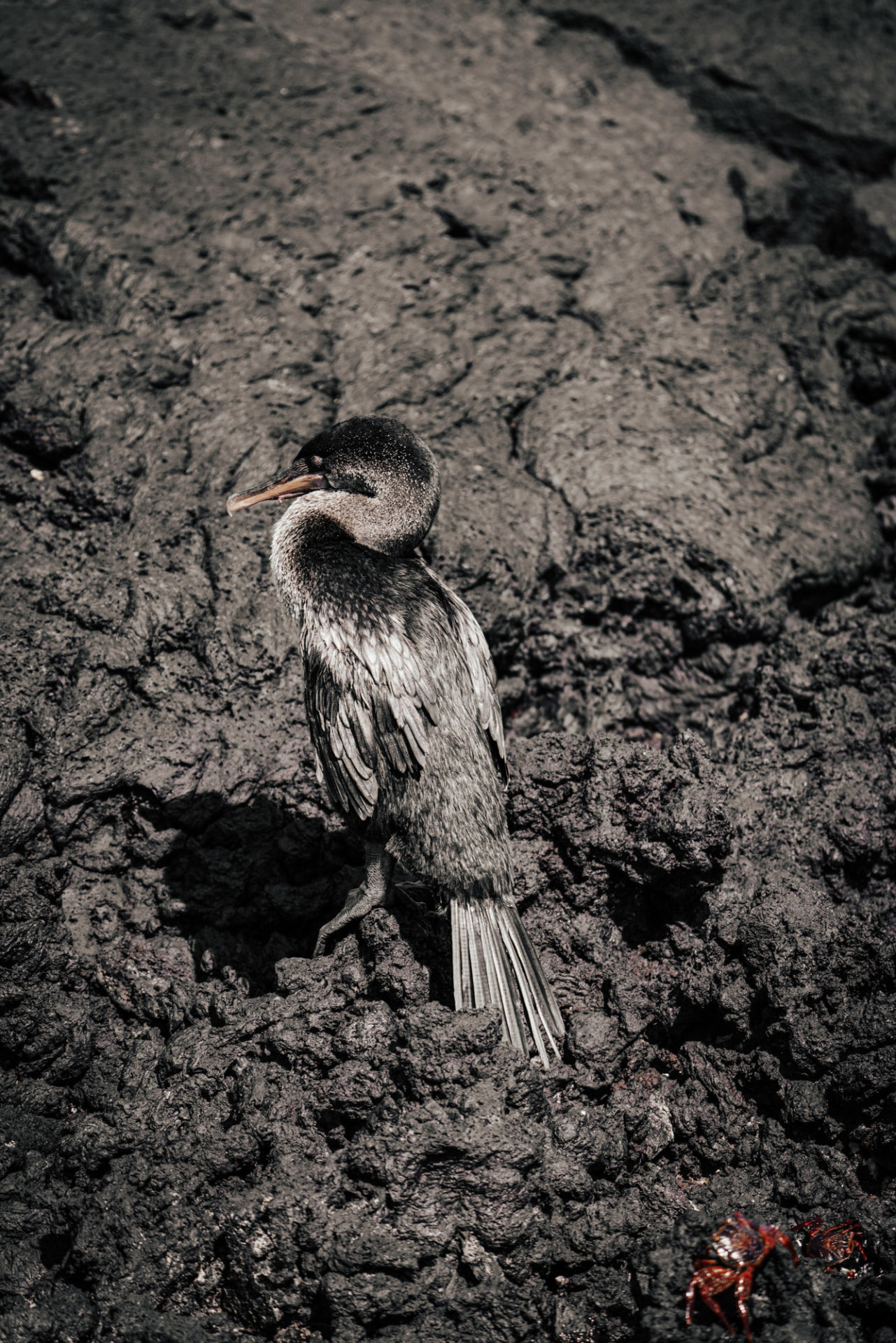
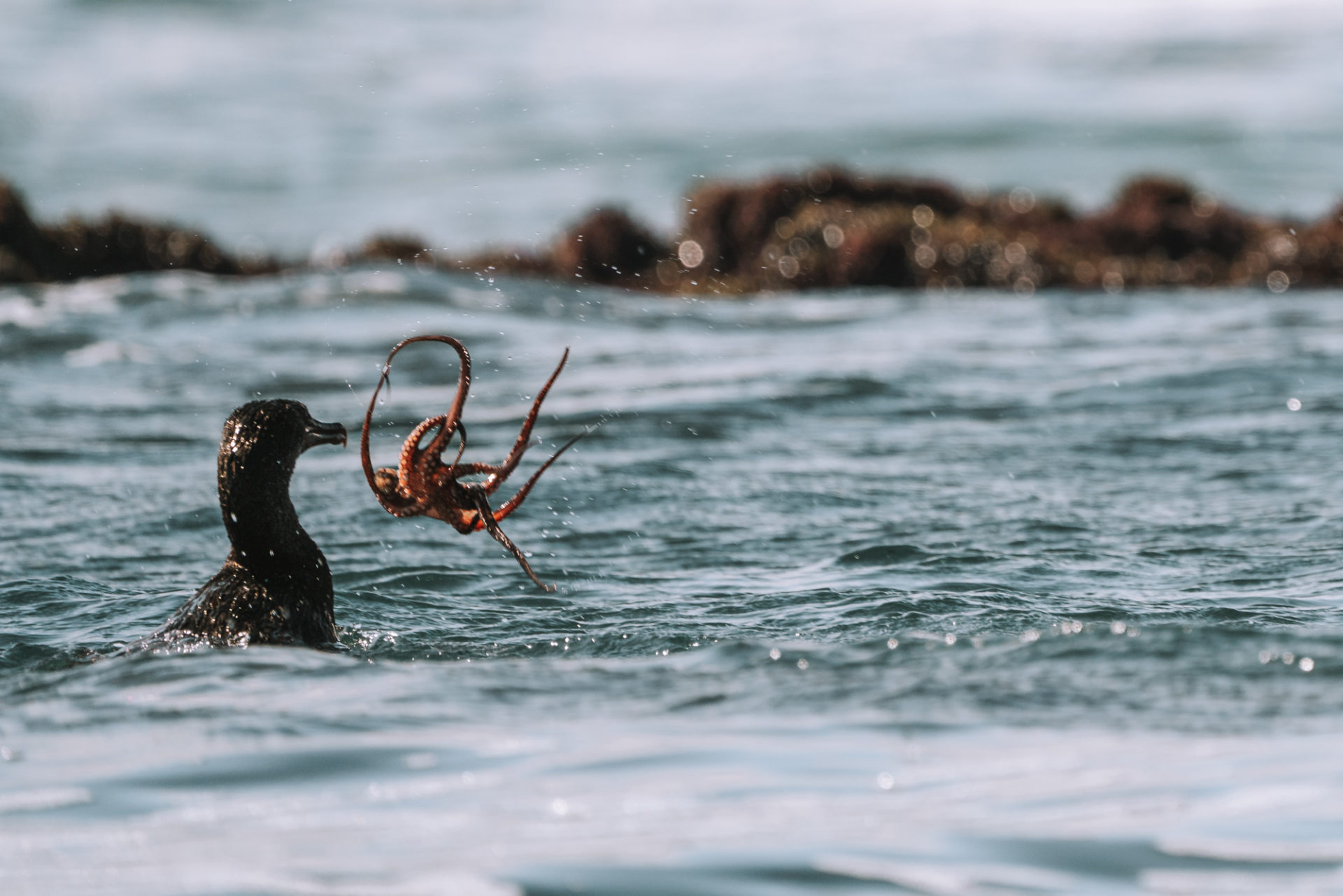
Nazca Booby
Status: Least Concern
Endemic to Galapagos: No
Where to See: Punta Suarez (Española), Punta Pitt (San Cristobal), and Genovesa.
The third and largest species of booby birds on the Galapagos Islands, the Nazca booby has grey feet and orange beaks. Like the others, Nazca boobies are excellent plunge divers and feed on small fish like sardines and anchovies.
Their reproduction process makes them rather unique animals that live in the Galapagos Islands. They lay two eggs during mating season. Both will hatch but only the larger and stronger baby will survive. The small, weak chick is killed, leaving each Nazca booby with only one offspring to care for.
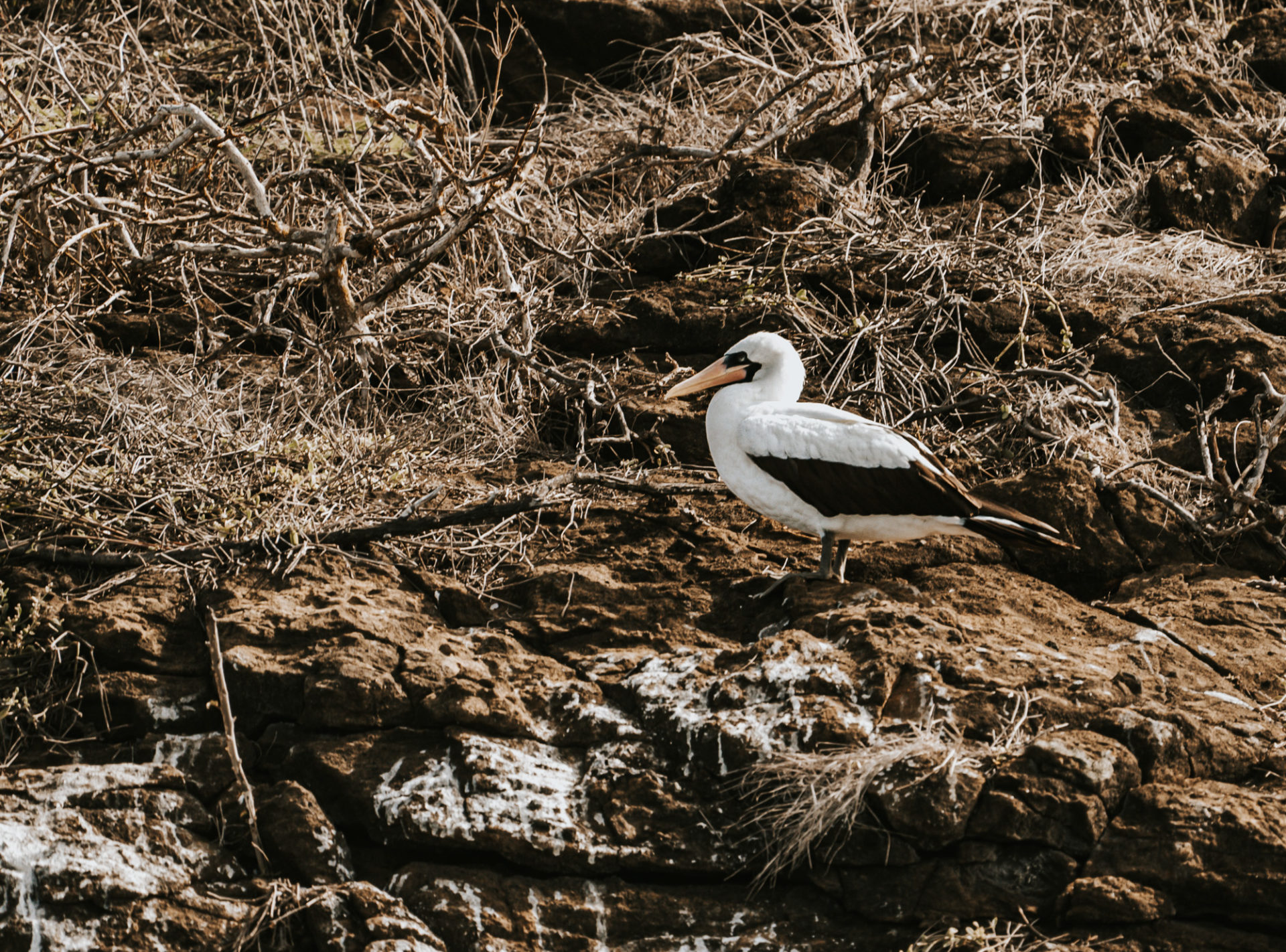
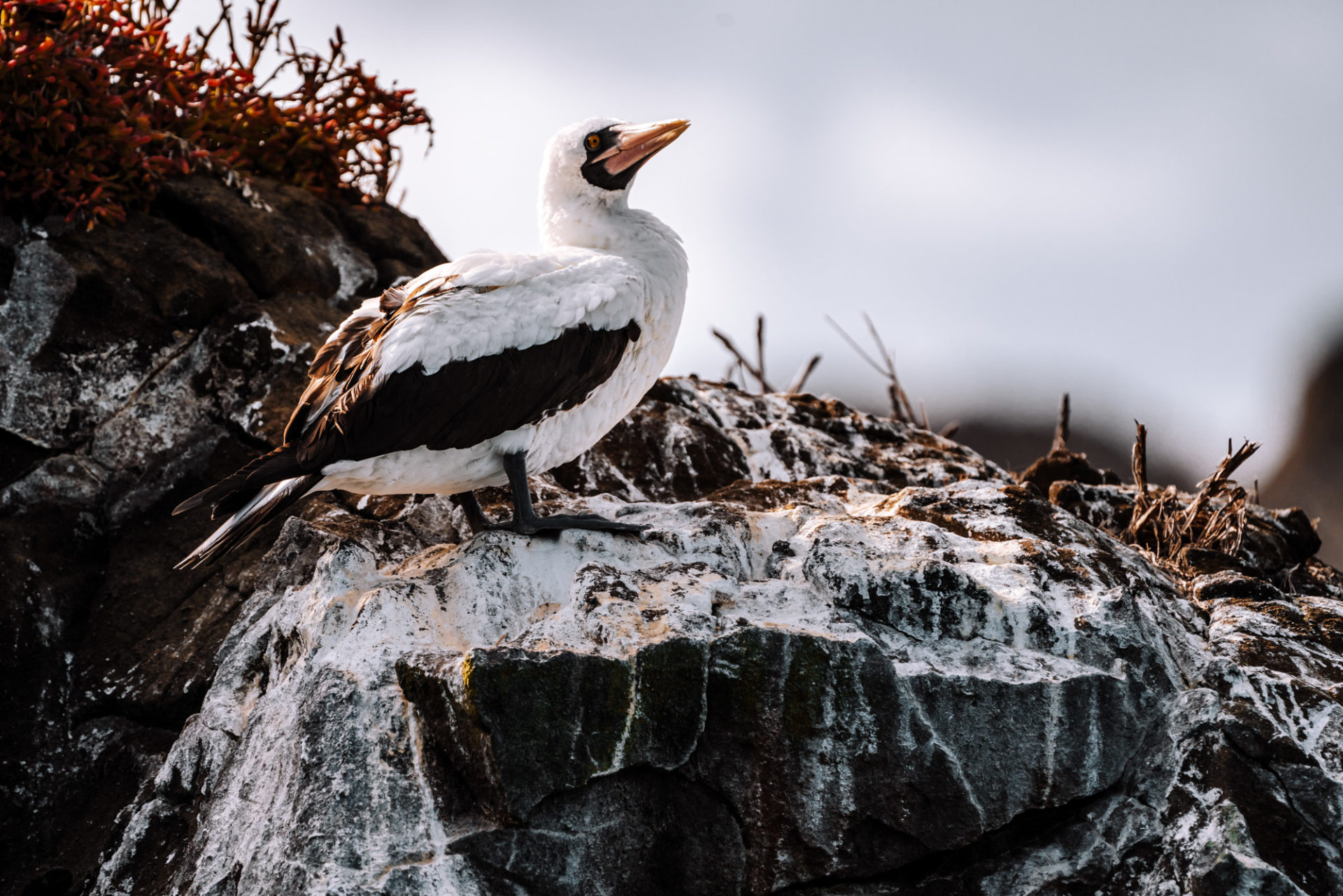
Waved Albatross
Status: Critically Endangered
Endemic to Galapagos: No
Where to See: Punta Suarez (Espanola Island)
The waved albatross is one of the largest of the Galapagos Island animals. It has a wingspan of a whopping 2.2 m (7 ft). The albatross are characterized by their white heads and dull yellow beaks, with a brown body and blueish feet.
They have a distinct courting ritual that includes dancing, clacking, waddling, and mooing like cows. Once the pairs have courted, they mate for life and have a lifespan of 30 years. The waved albatross is critically endangered, with only 12,000 breeding pairs scattered around the Galapagos, Colombia, and Peru. And sadly, we have yet to see one in the wild!
Galapagos Dove
Status: Least Concern
Endemic to Galapagos: Yes
Where to See: Scattered around arid lowlands, especially on Genovesa Island
Known to be tame and curious, the Galapagos Dove is another amazing feat of evolution. They prefer dry, arid areas where the Opuntia cactus grows and have taken on the role of pollinators in the absence of bees on the Galapagos Islands.
Unlike Darwin’s finches, the doves spend most of their time on the ground instead of in the air. They are reddish-brown with black and white markings and have red feet with a distinct blue ring around the eye. You’ll find them foraging for seeds and fruits or pretending to be injured when they feel threatened.
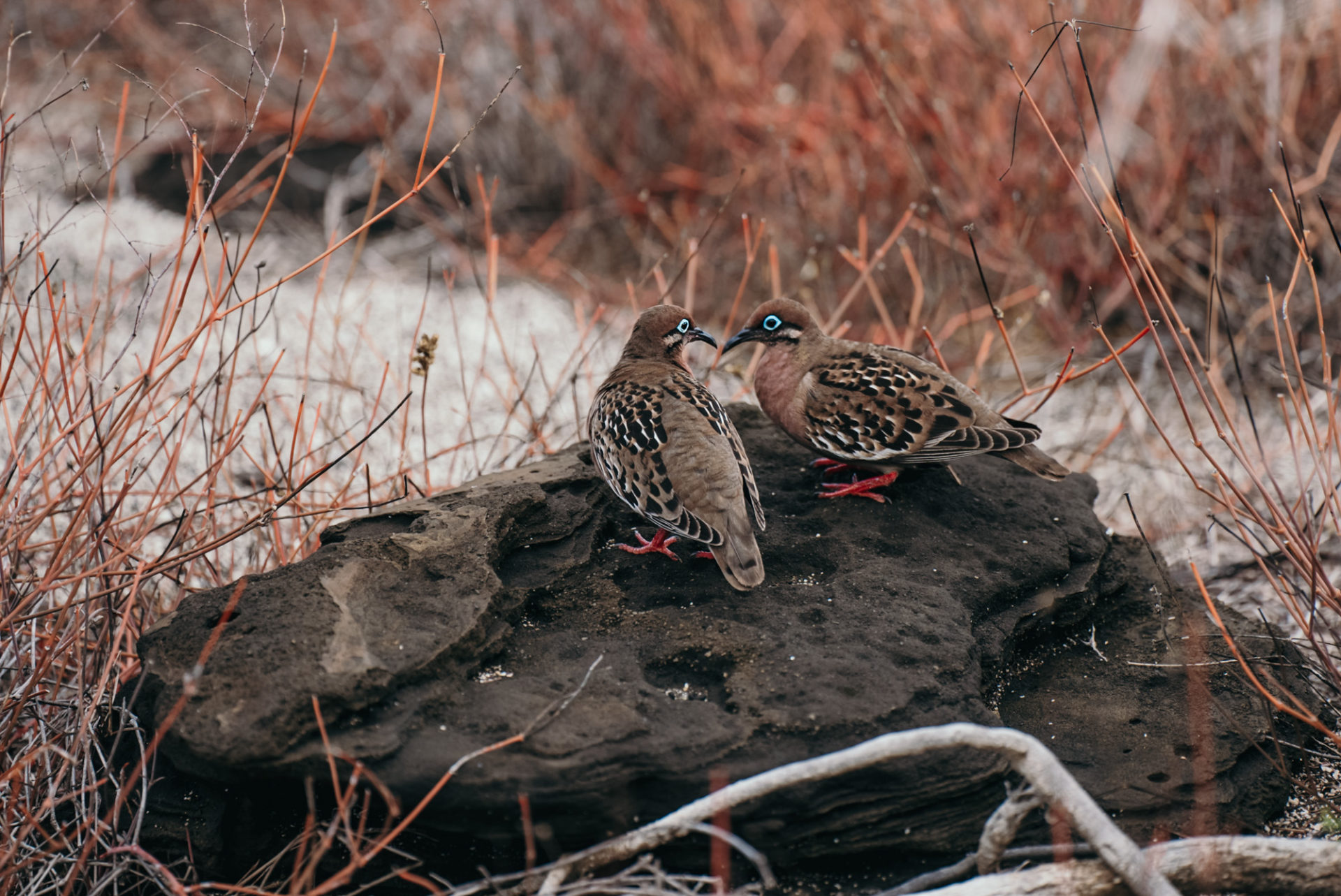
Marine Animals of the Galapagos
Galapagos Shark
Status: Least Concern
Endemic to Galapagos: No
Where to See: Waters around Wolf and Darwin Islands
Warm-water Galapagos sharks are surprisingly not endemic to the Galapagos Islands despite their name. The Galapagos shark is a type of requiem shark that closely resembles a reef shark. They are large with slender bodies and 14 rows of serrated teeth.
You might see a Galapagos shark while diving, as they’re usually found around 100m in depth. They feed on bony fish and are even known to be cannibalistic toward shark pups.
Sally Lightfoot Crab
Status: Least Concern
Endemic to Galapagos: No
Where to See: Scattered all over the beaches and shallow waters of the archipelago
Sally lightfoot crabs are common Galapagos Islands creatures that you’ll often see crawling along the shores and beaches. They’re easy to spot thanks to their bright red colouring and blue markings. Though very common in the Galapagos, they can also be found all over the western coast of South and Central America.
The diet of a sally lightfoot crab is pretty broad as they’ll eat pretty much anything. This makes them critical to the ecosystem since they keep beaches clean of organic debris and eat ticks off of the marine iguana. They’re quick, hard to catch and get more colourful with every moulting cycle.

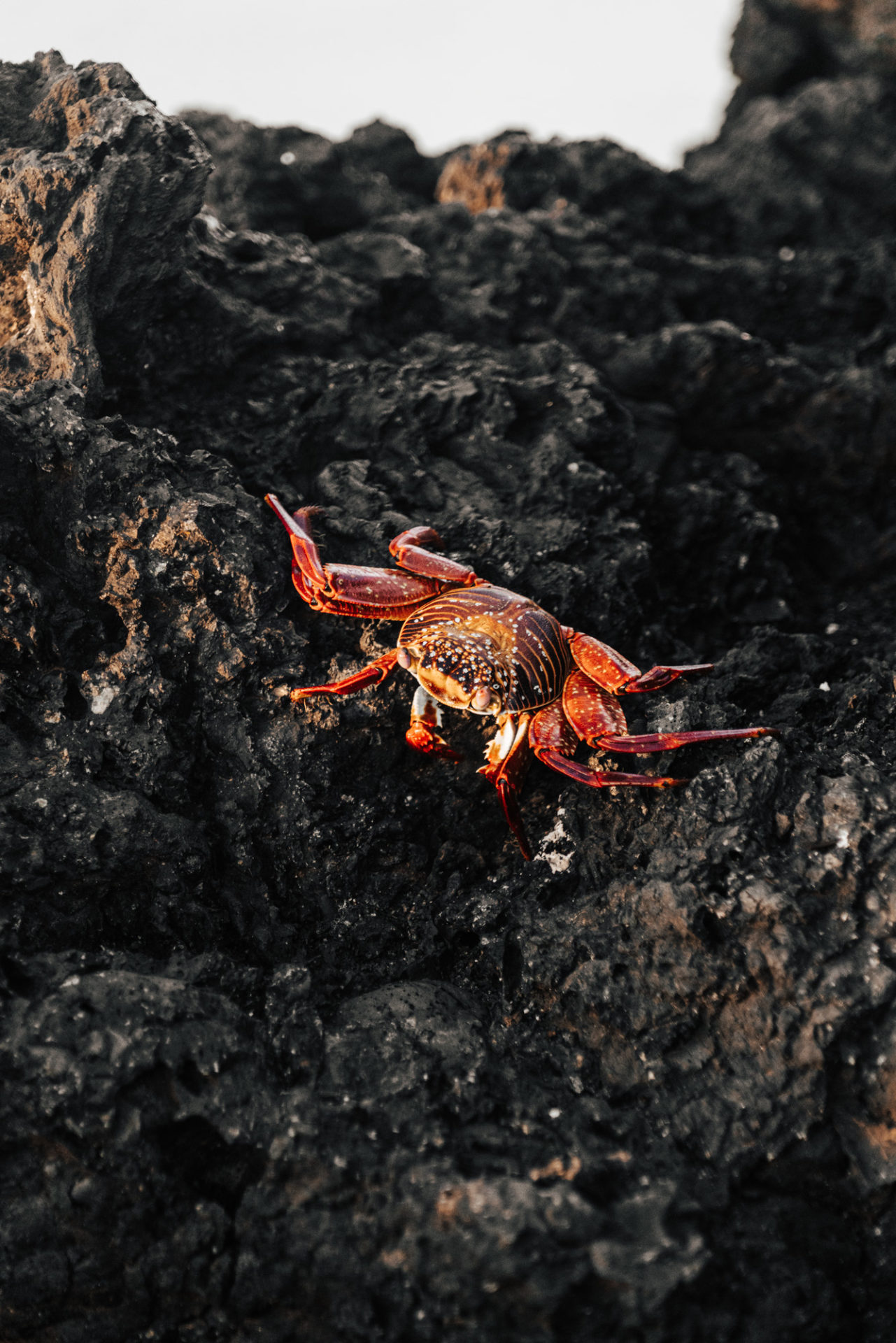
Have you been lucky enough to see any of these unique Galapagos Islands animals?
READ NEXT: 18 Most Common Birds of Galapagos

